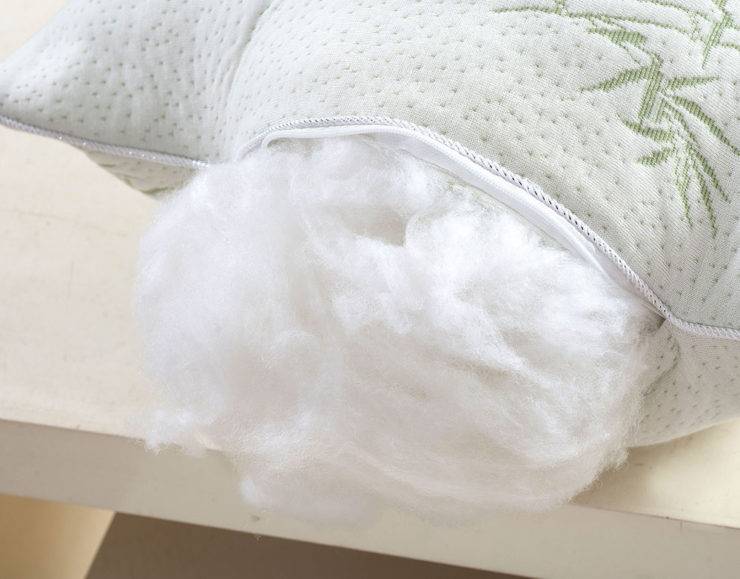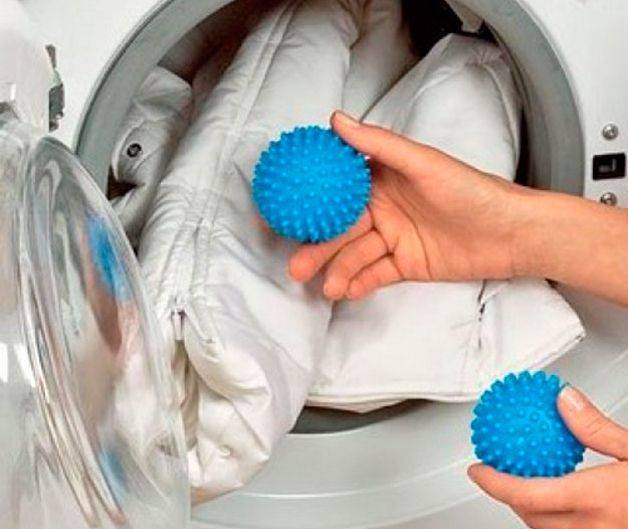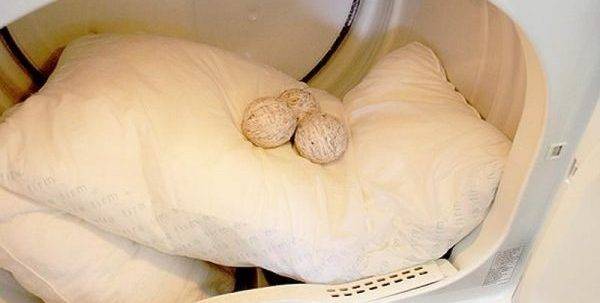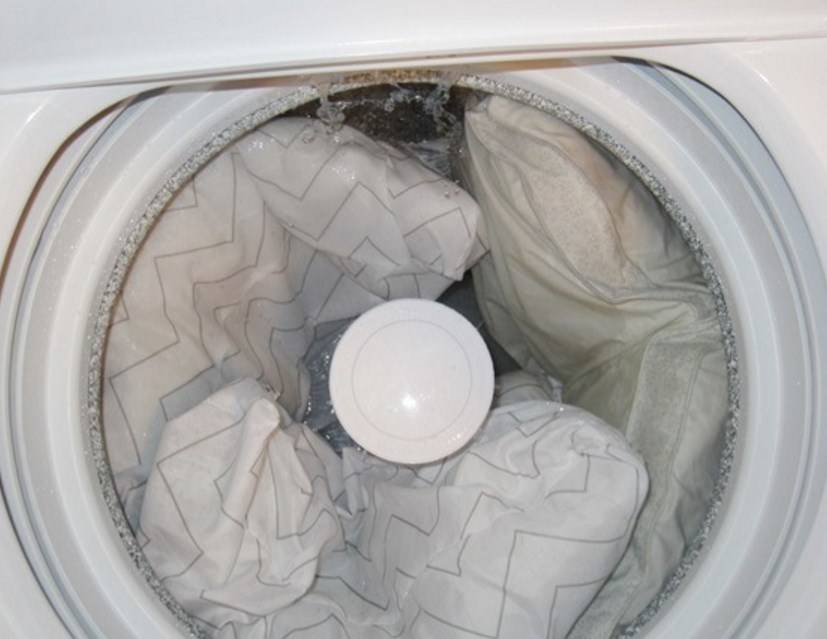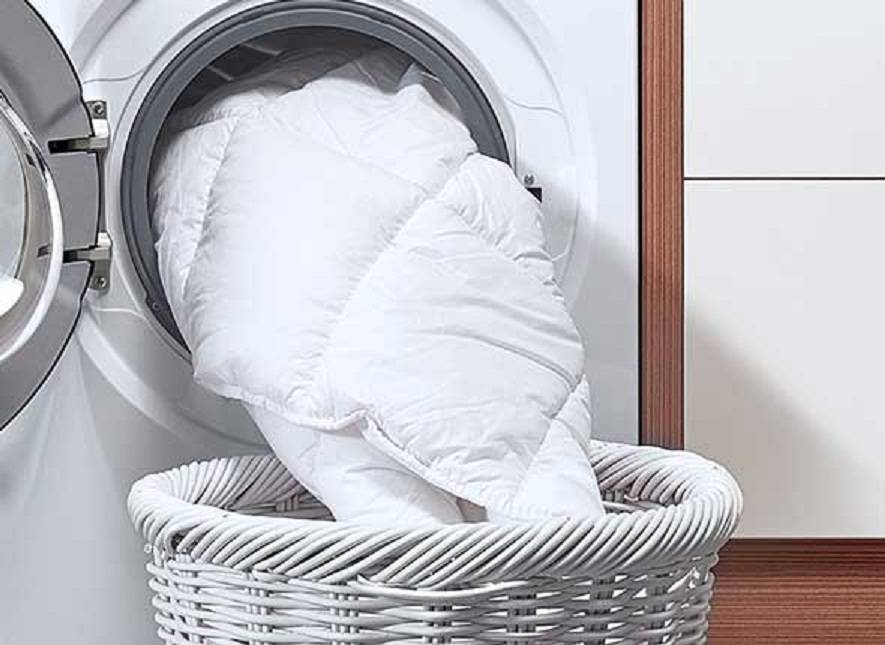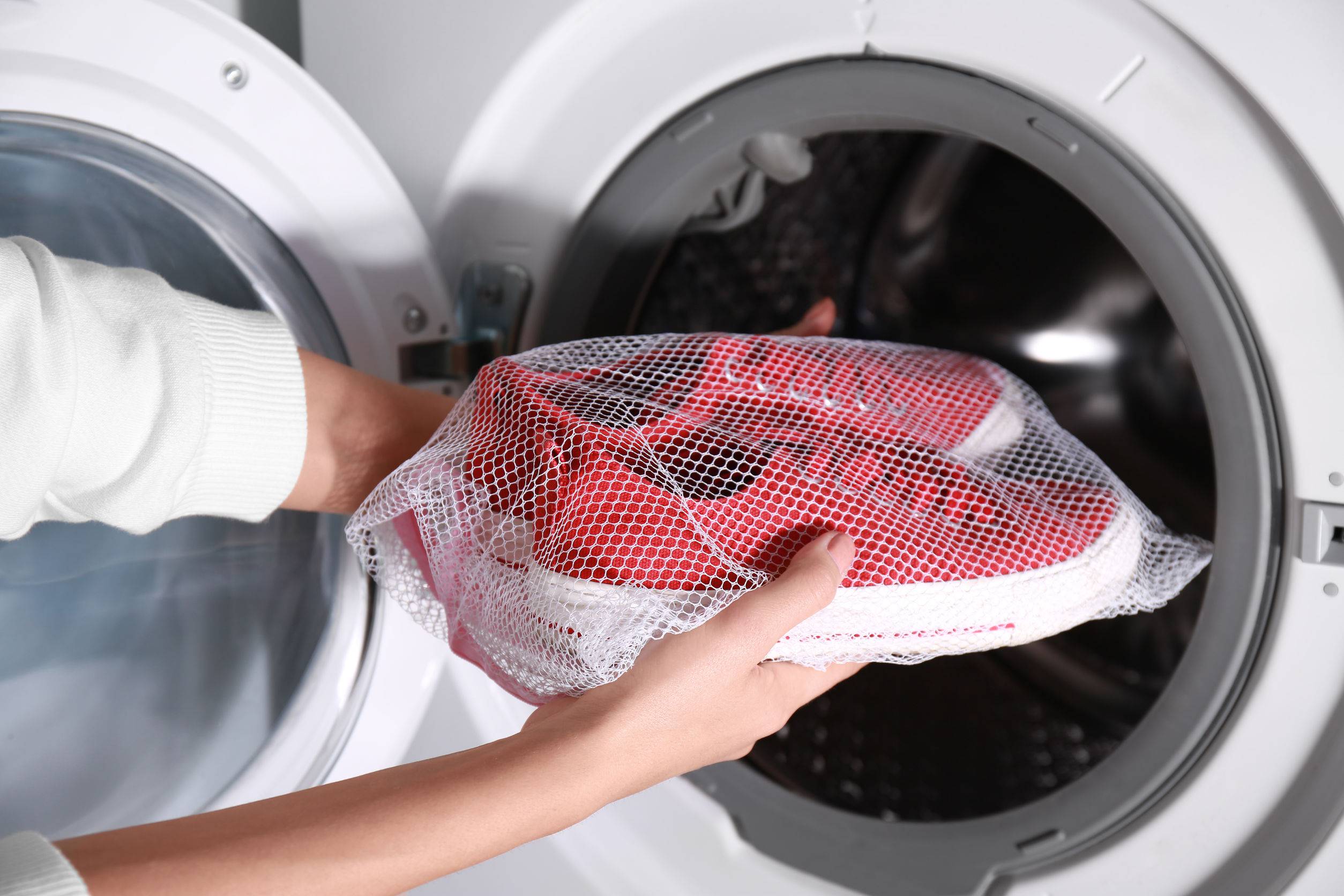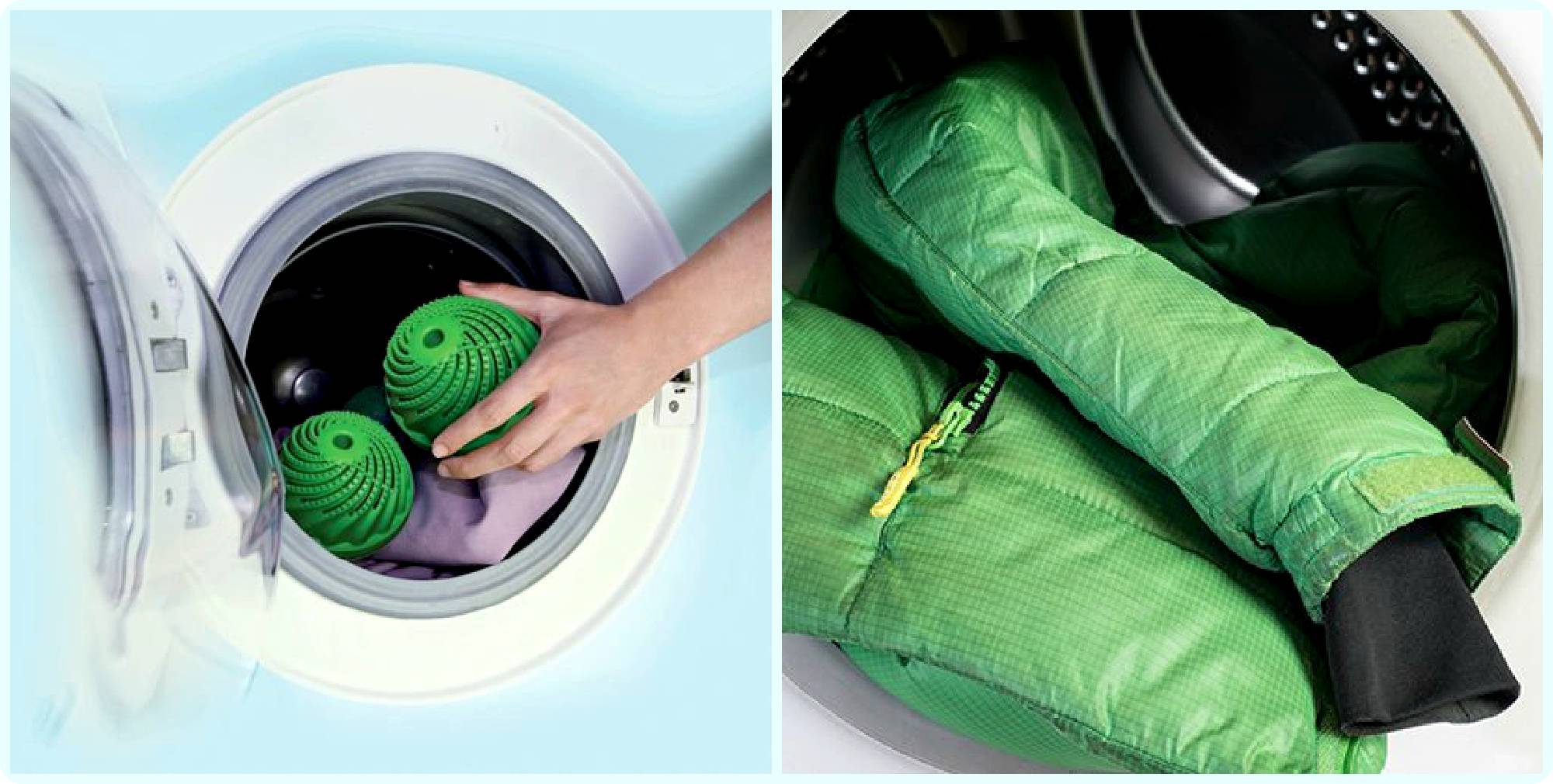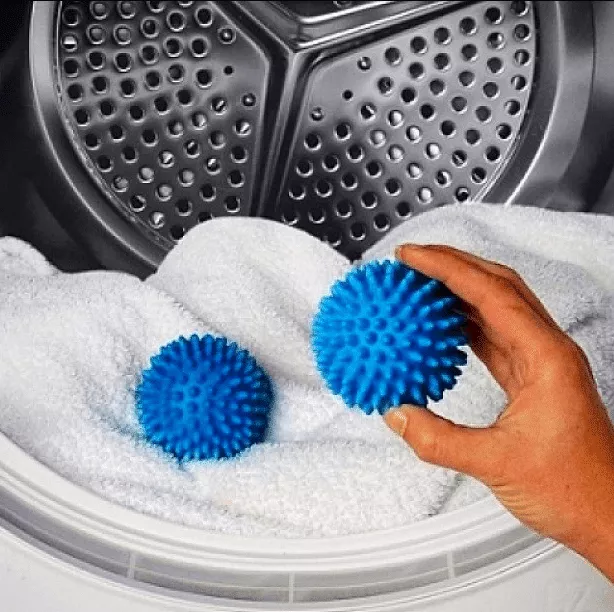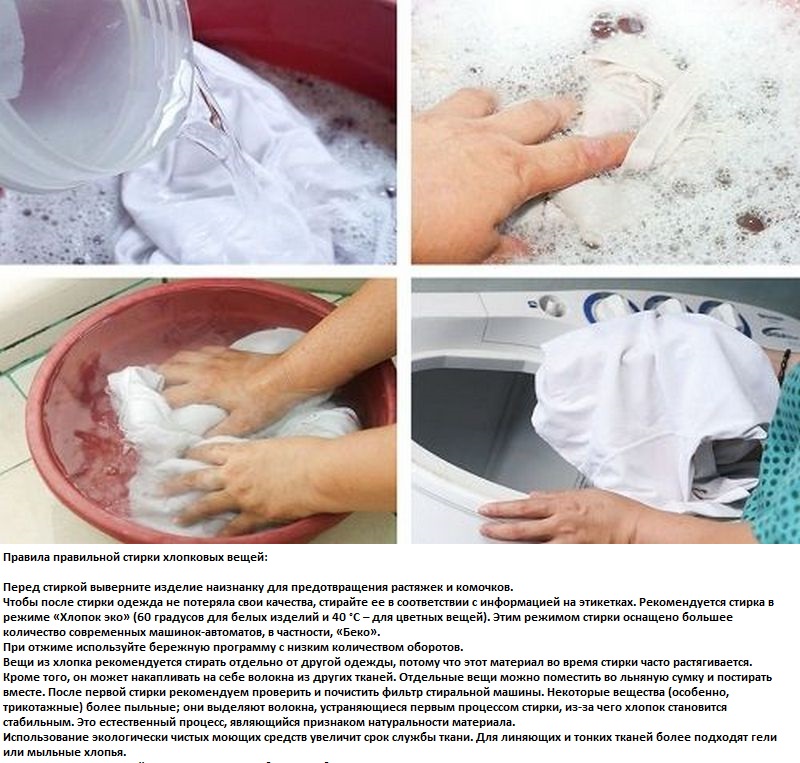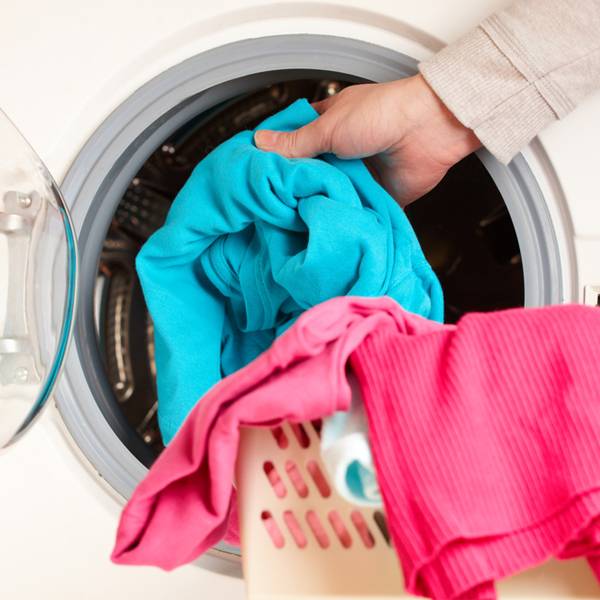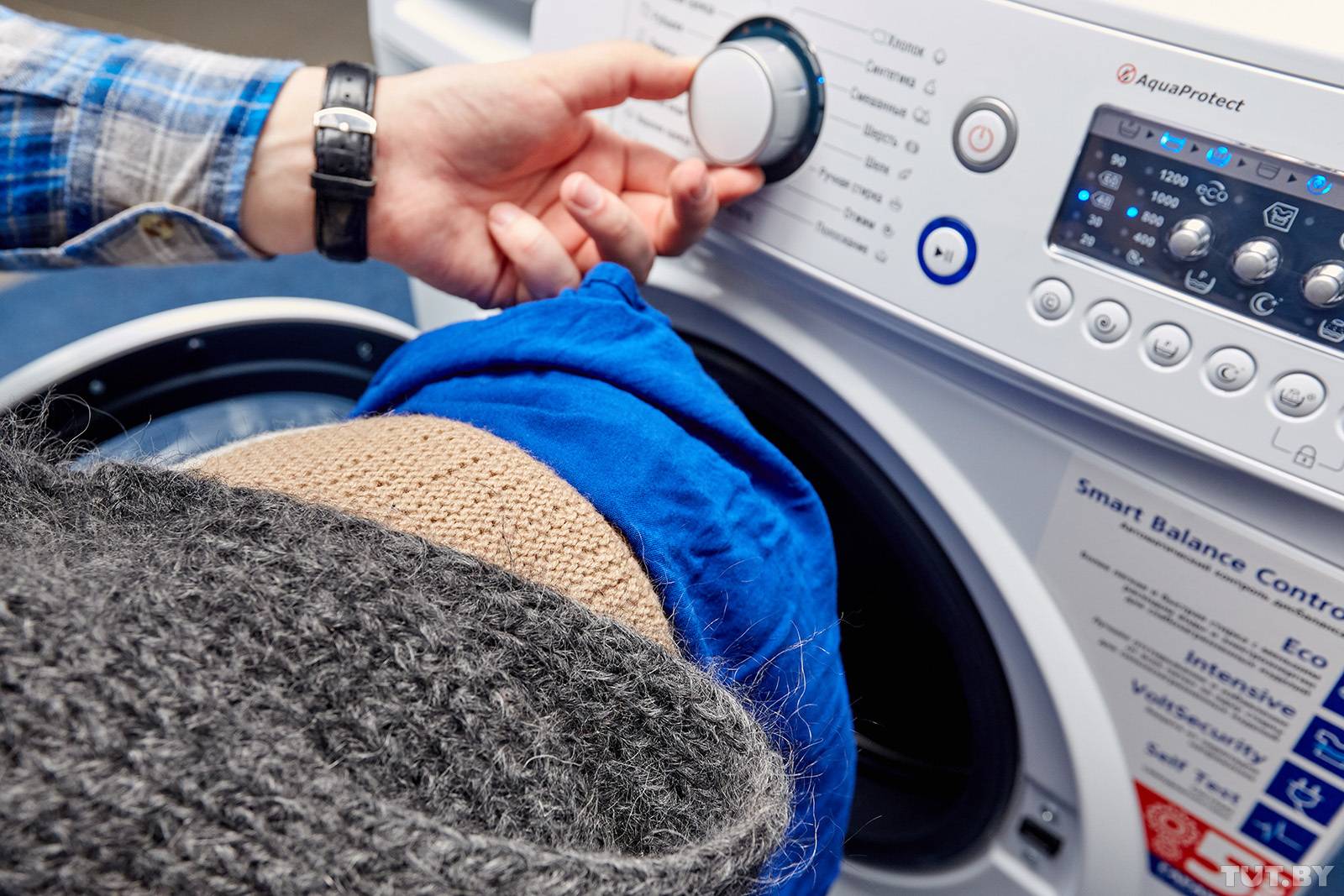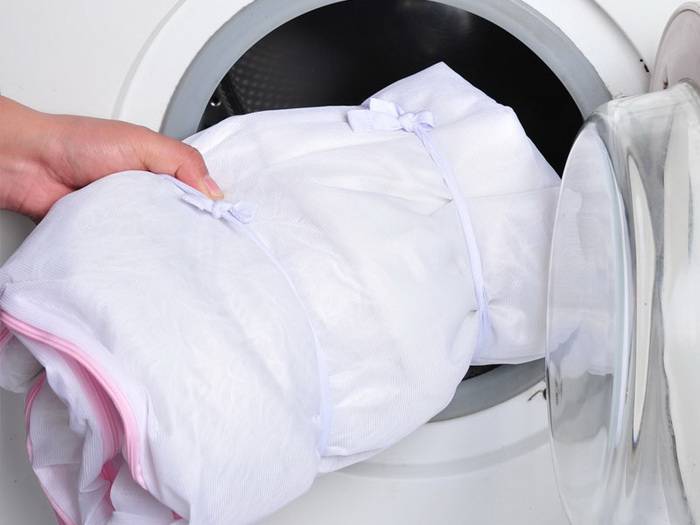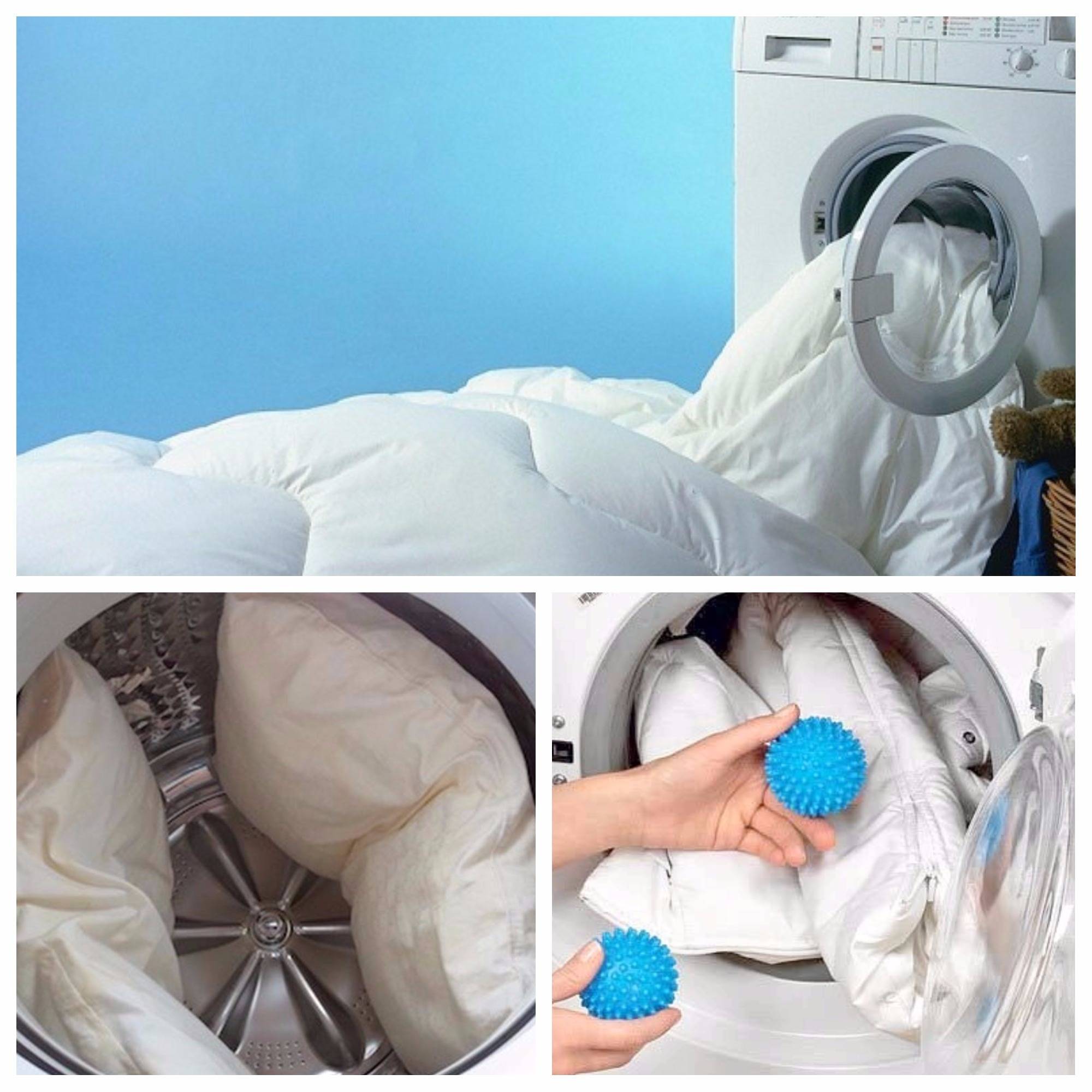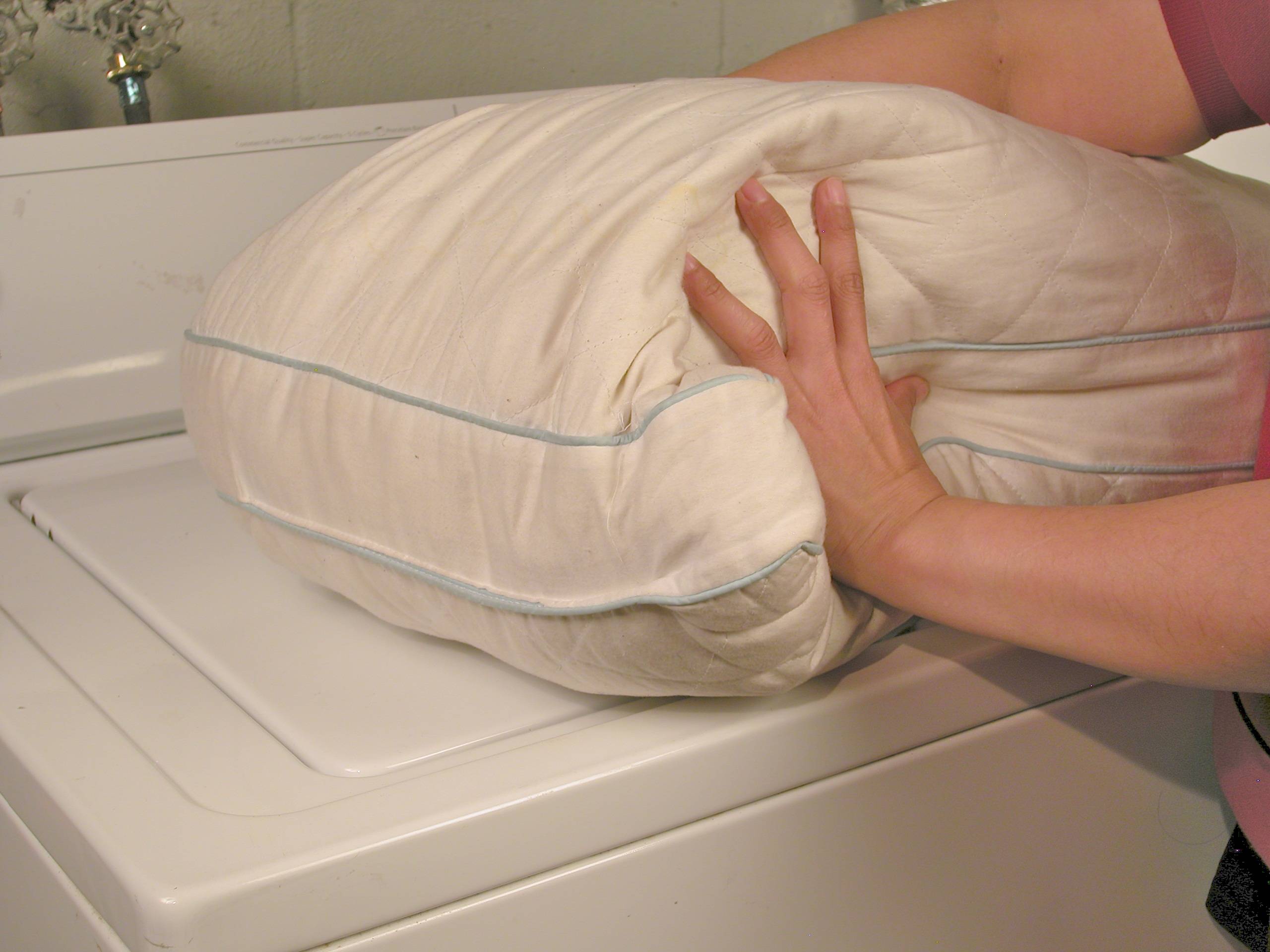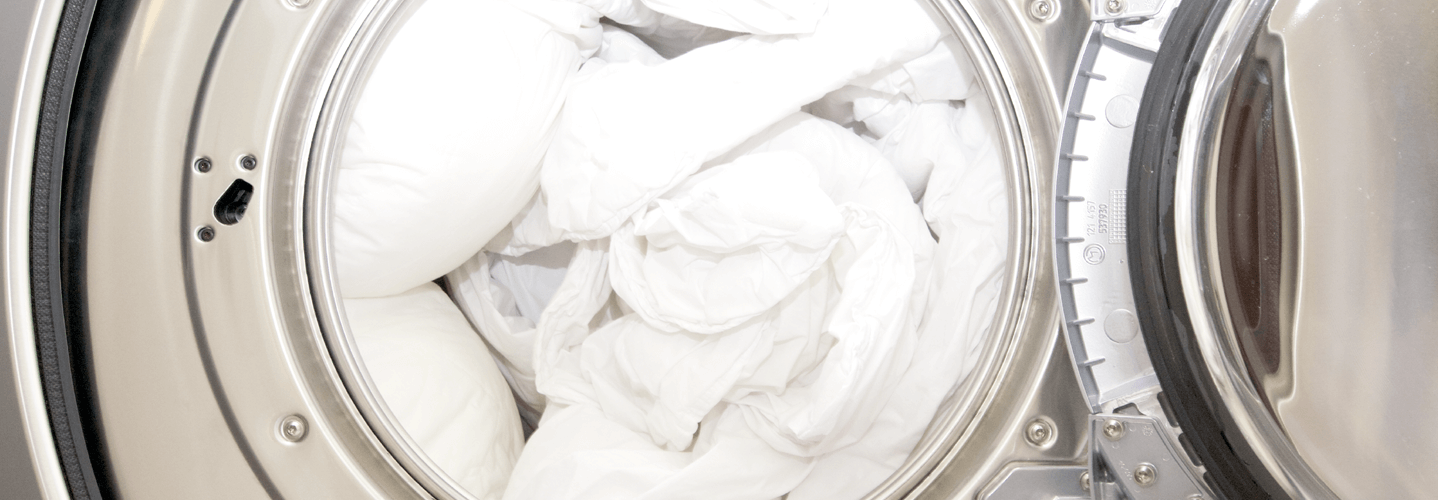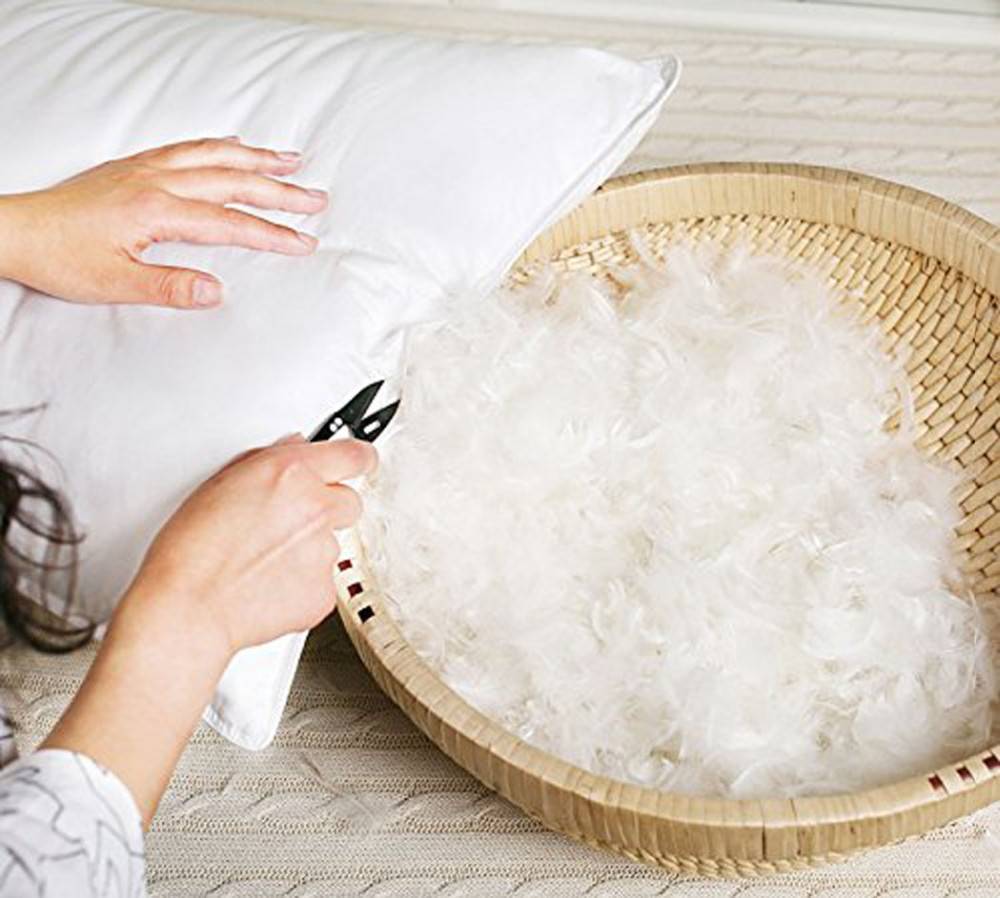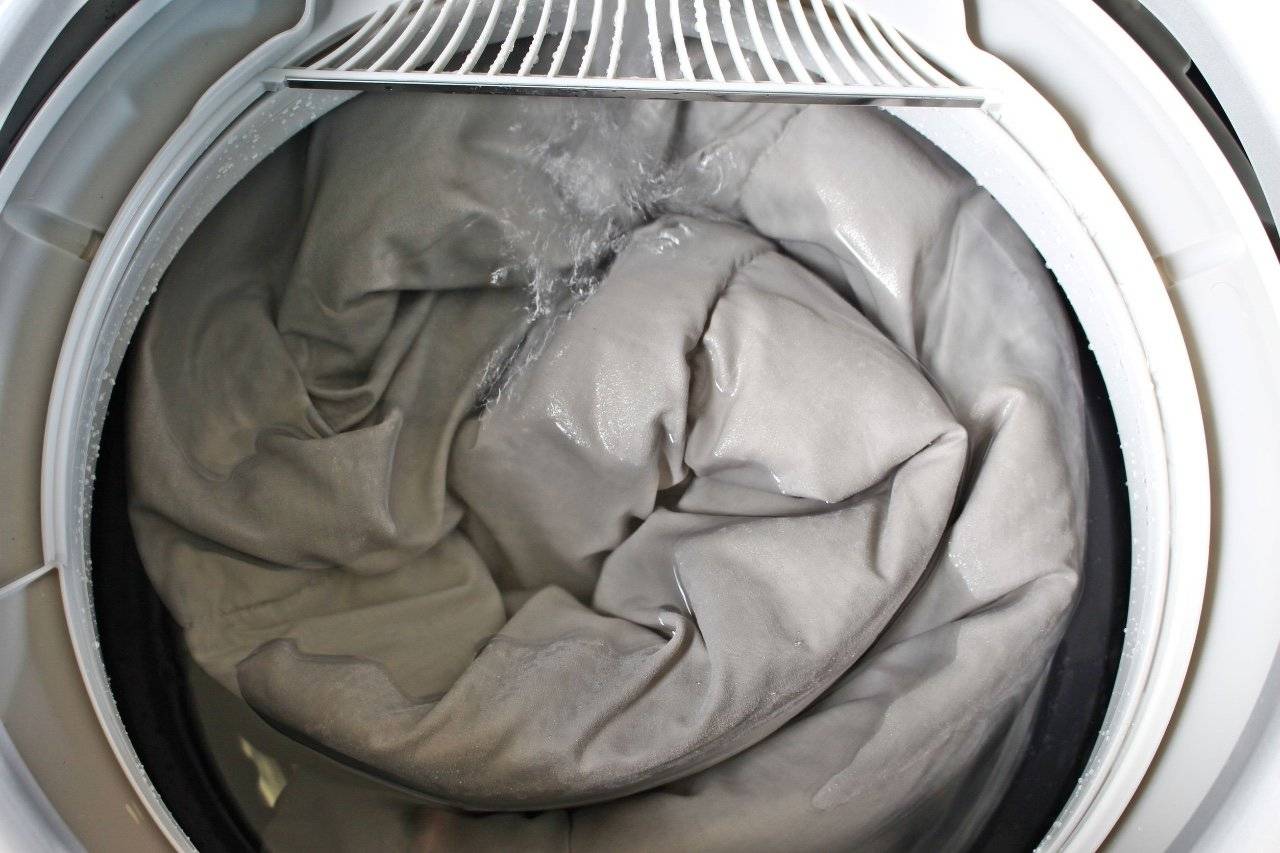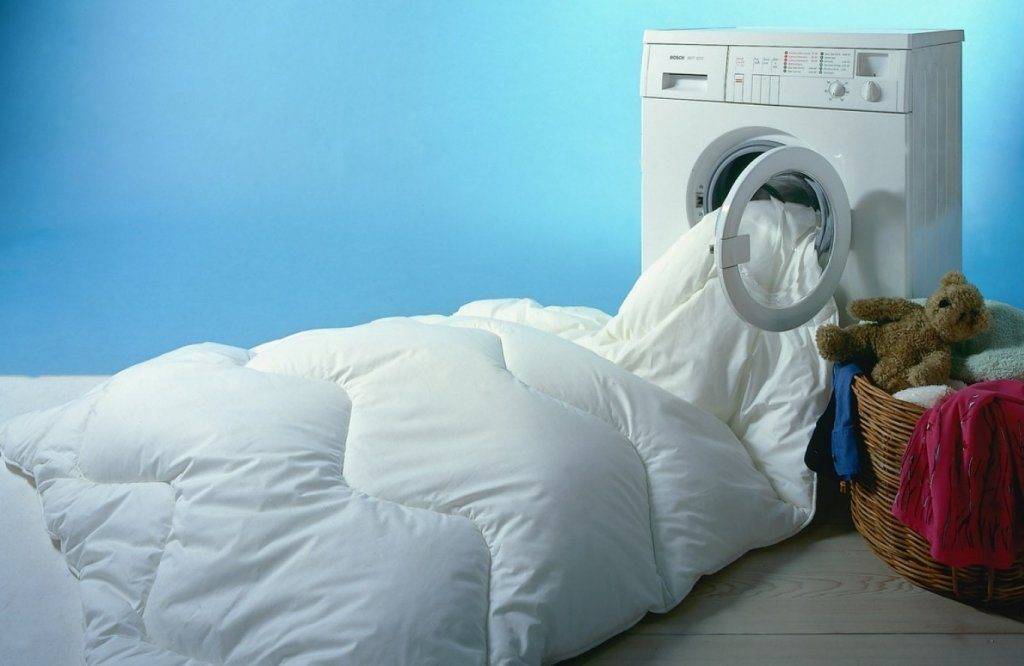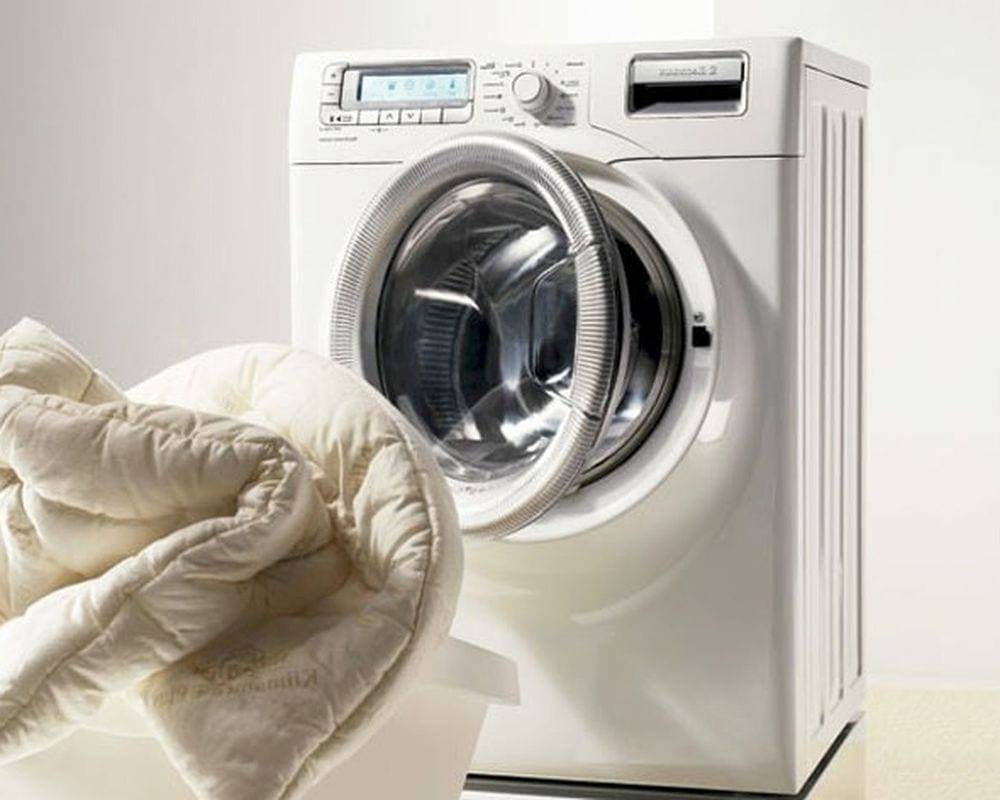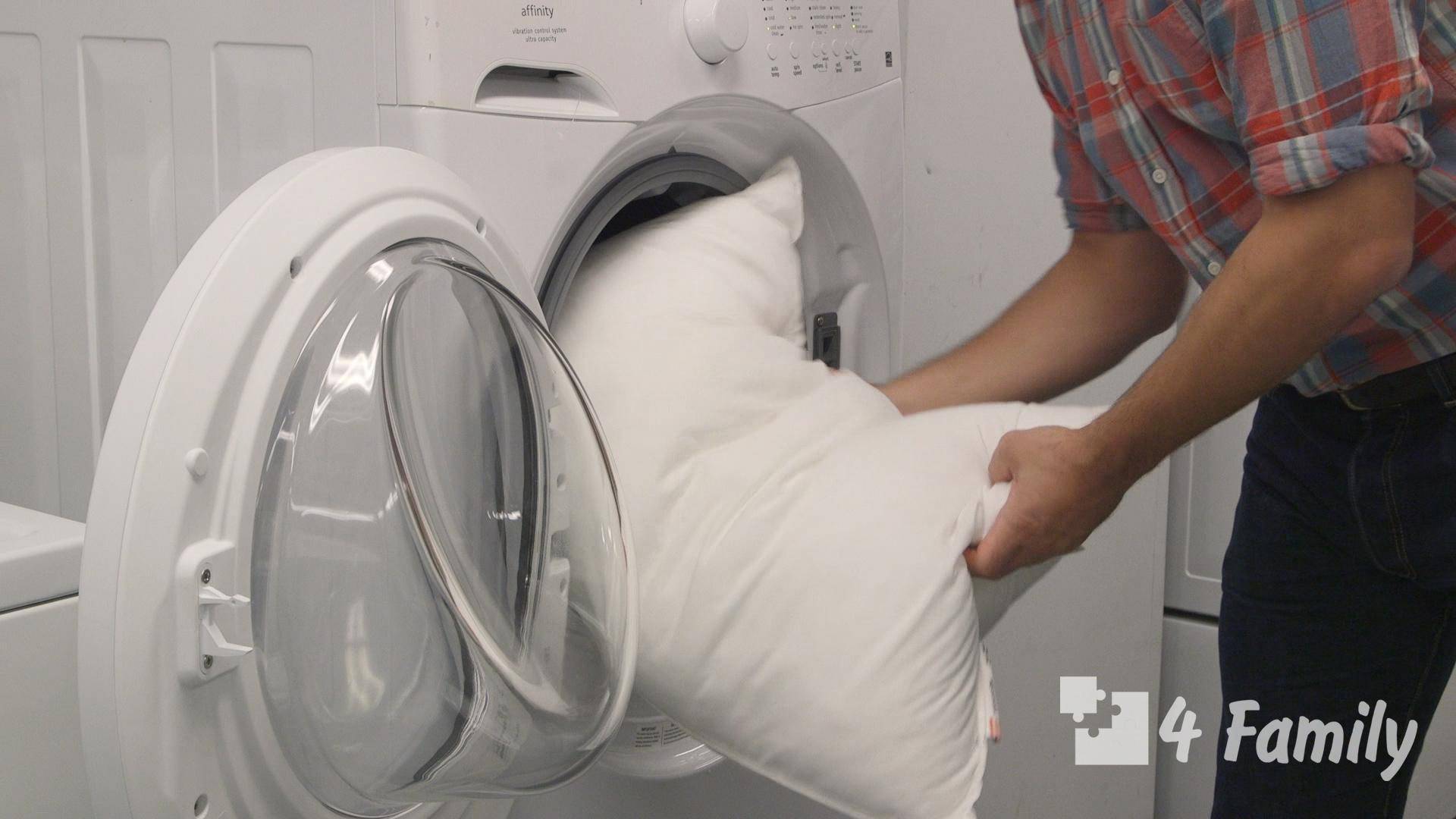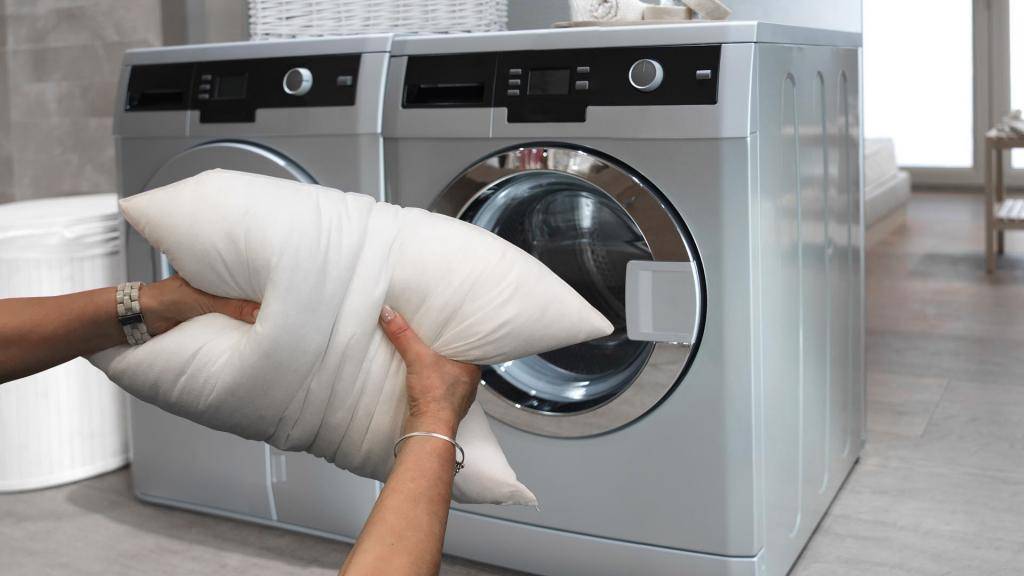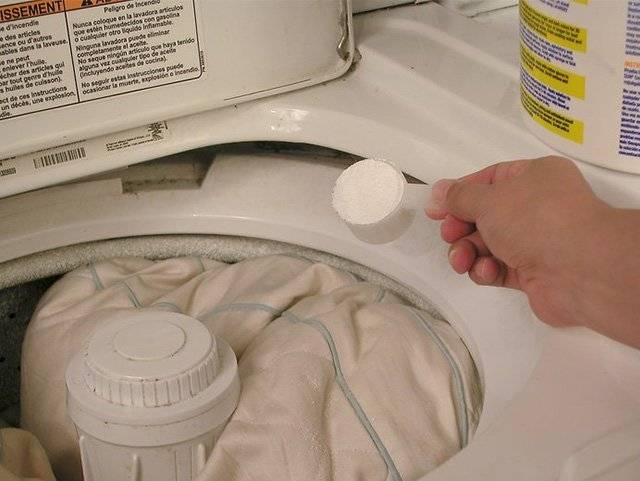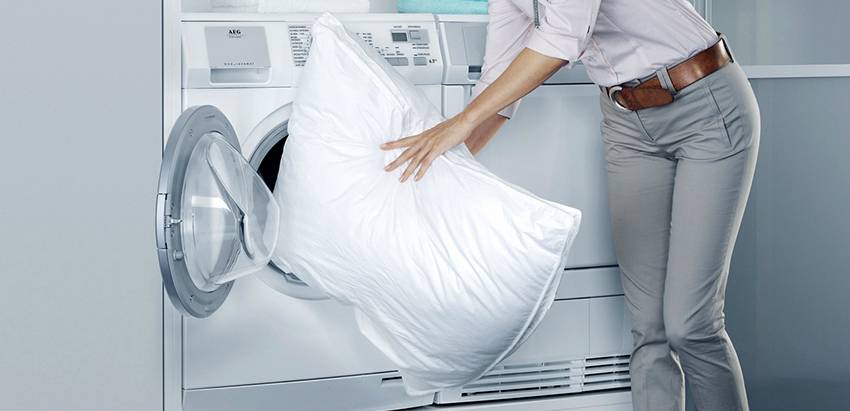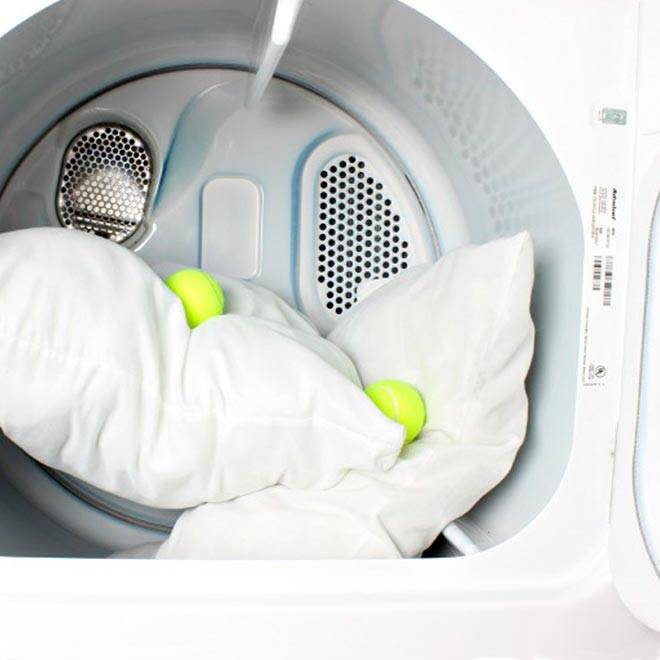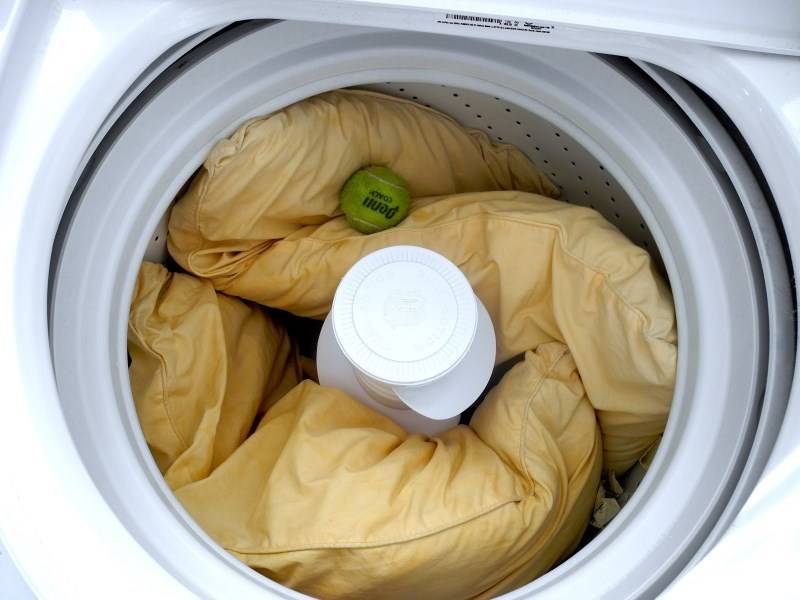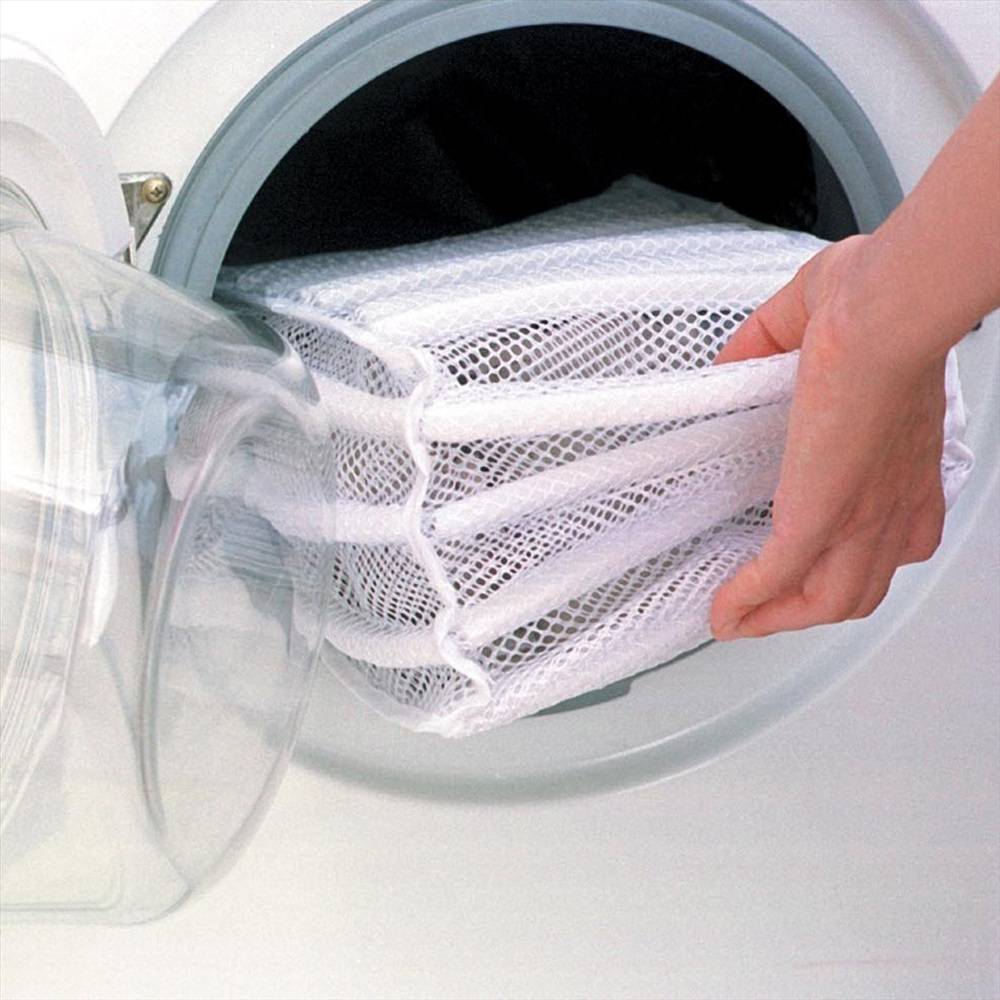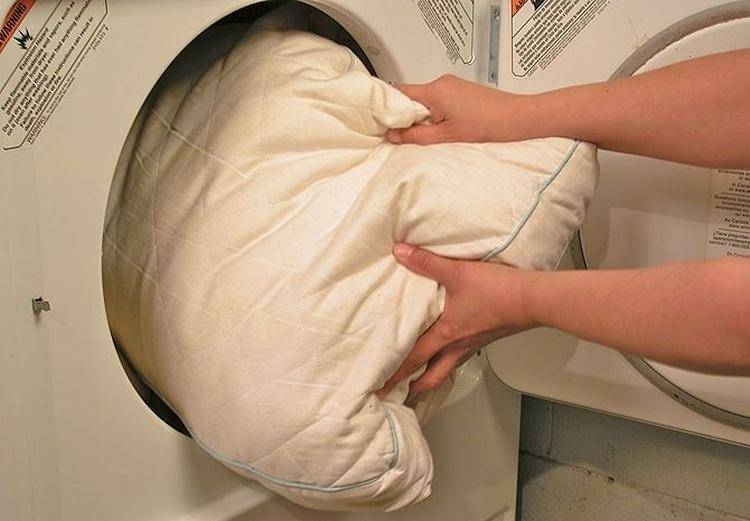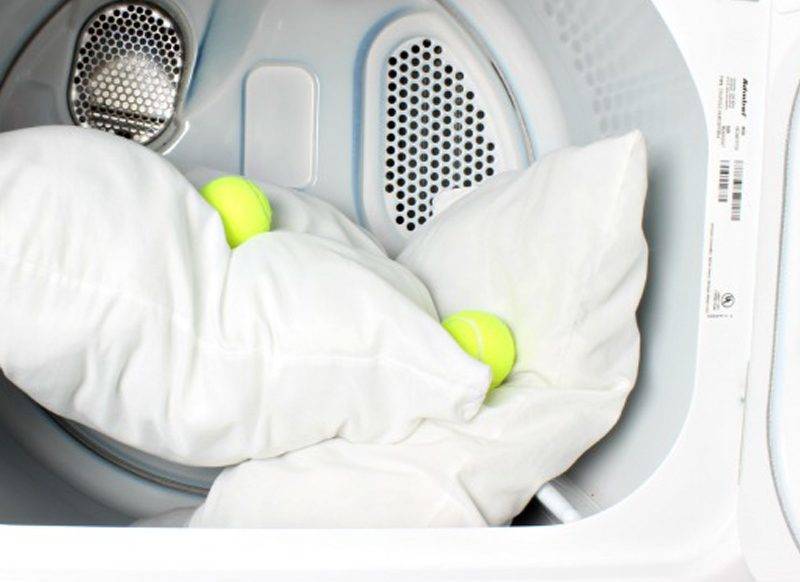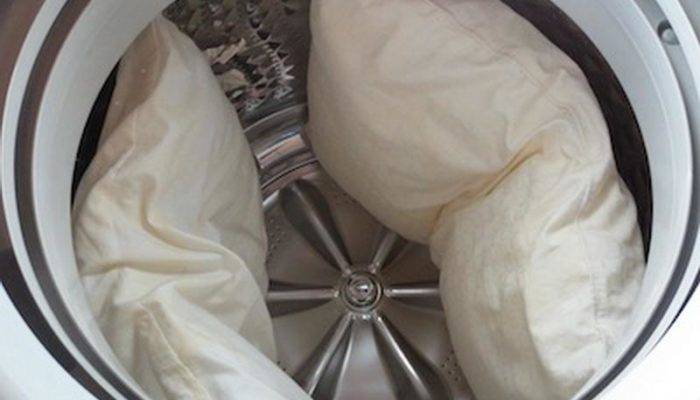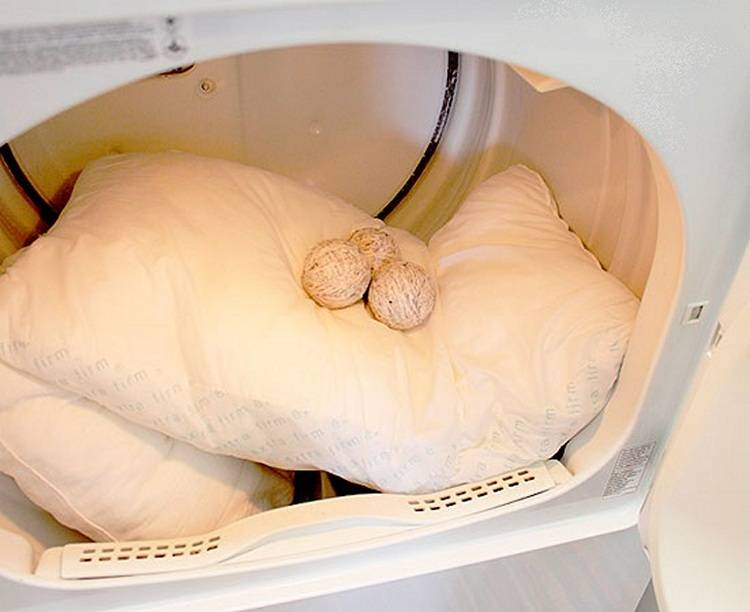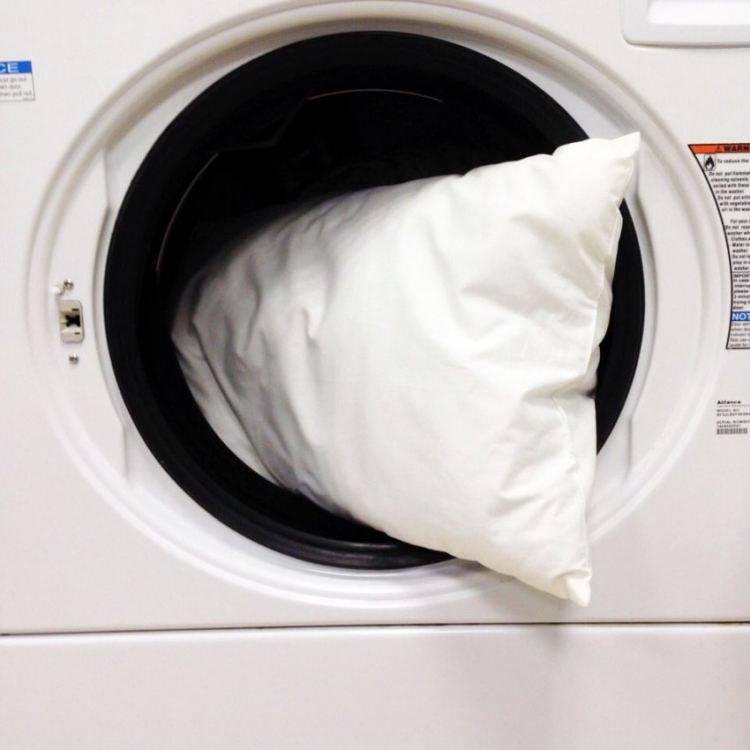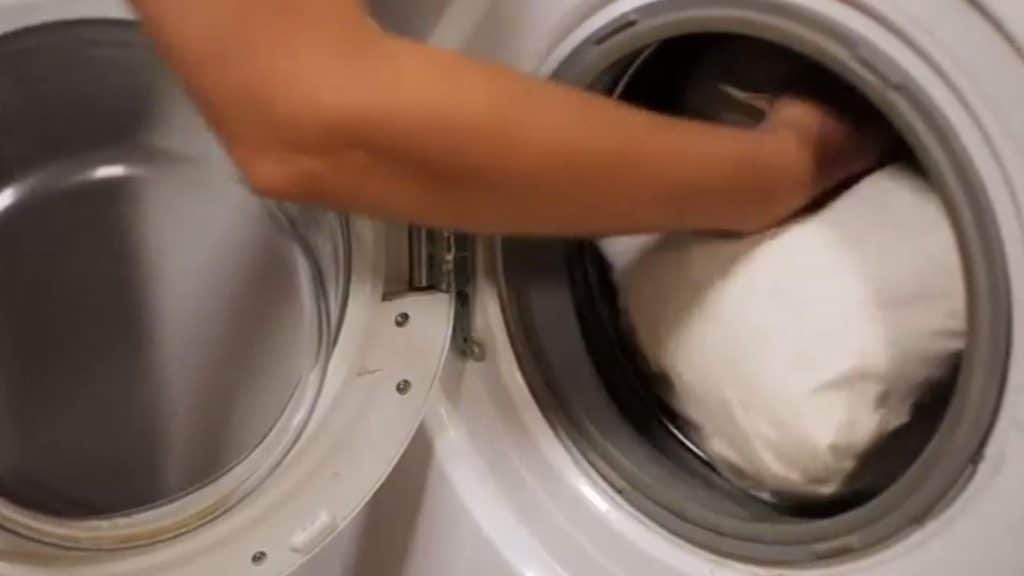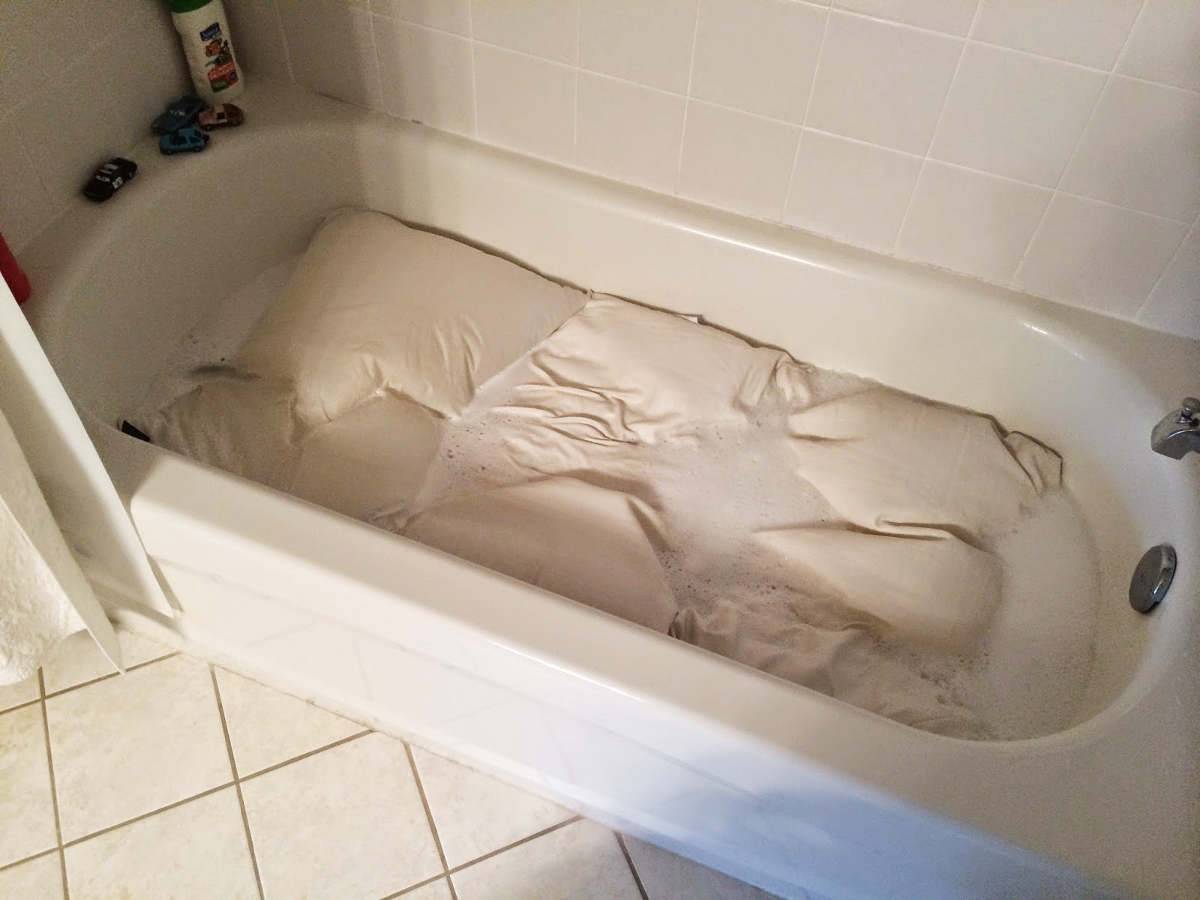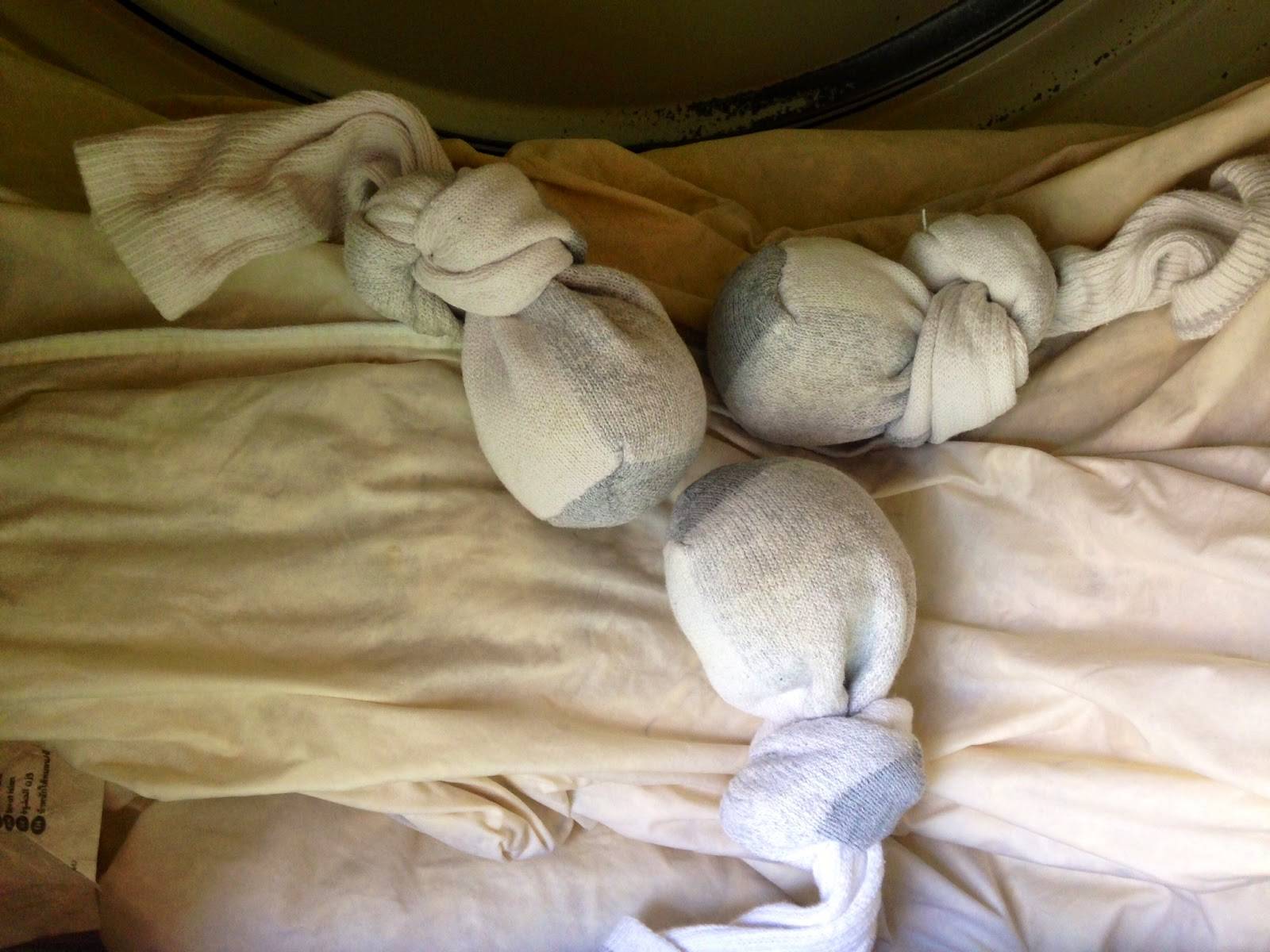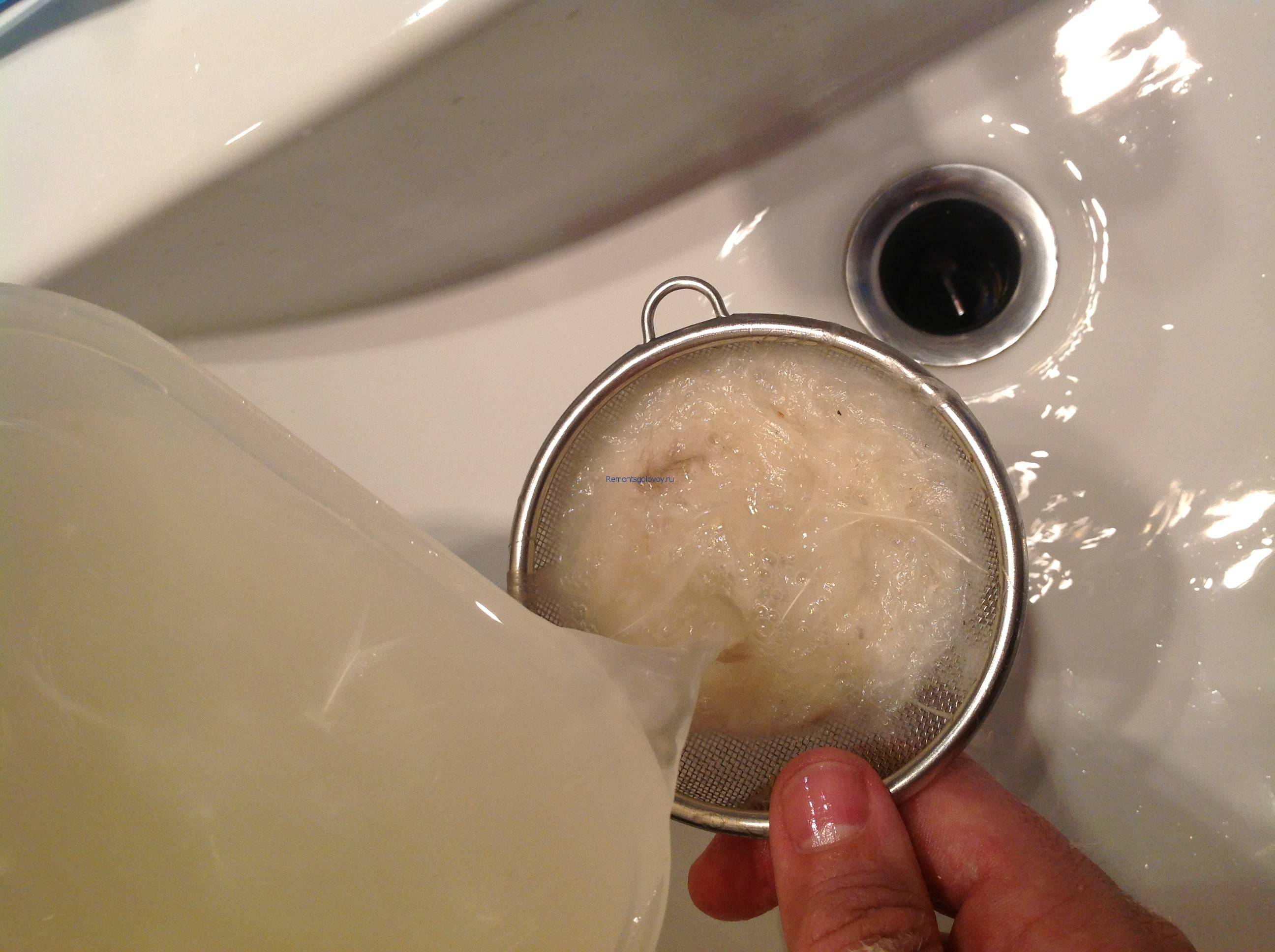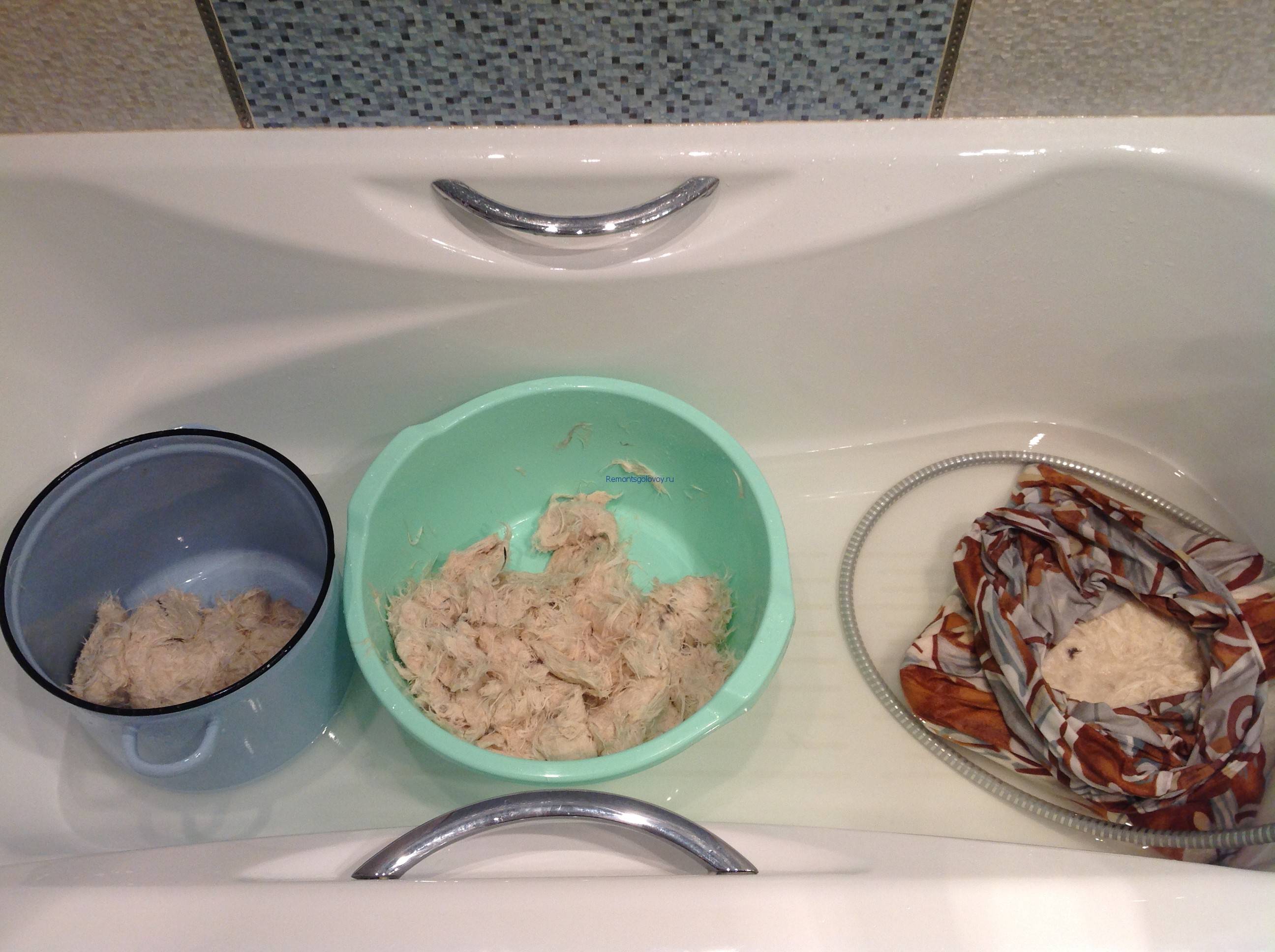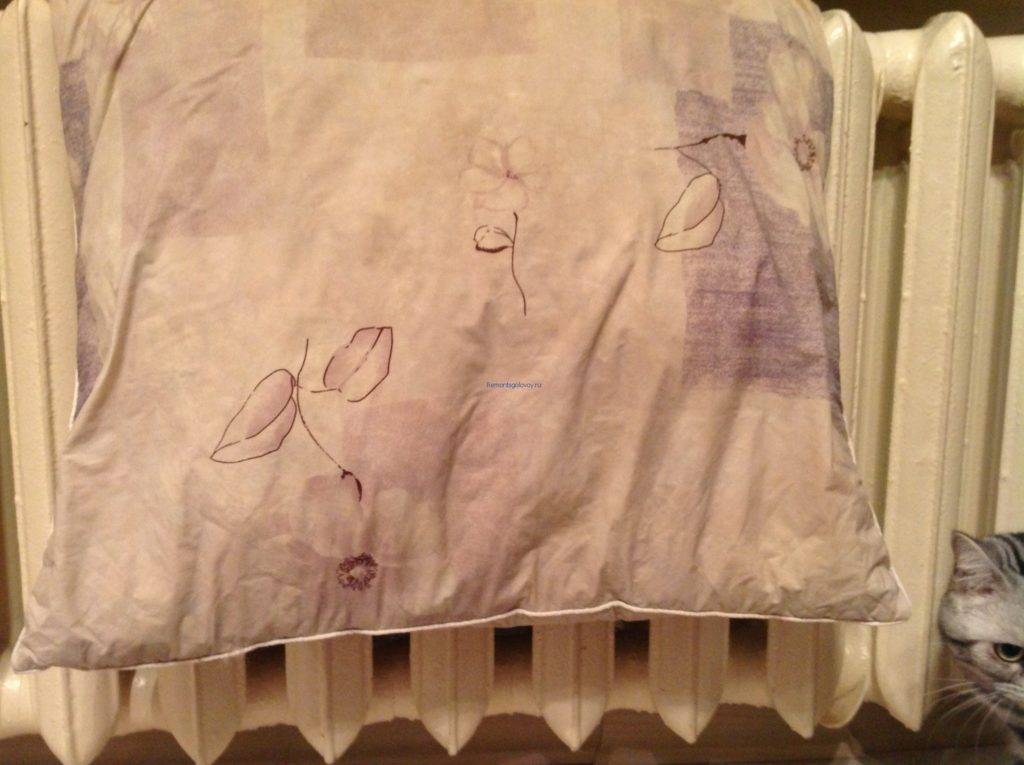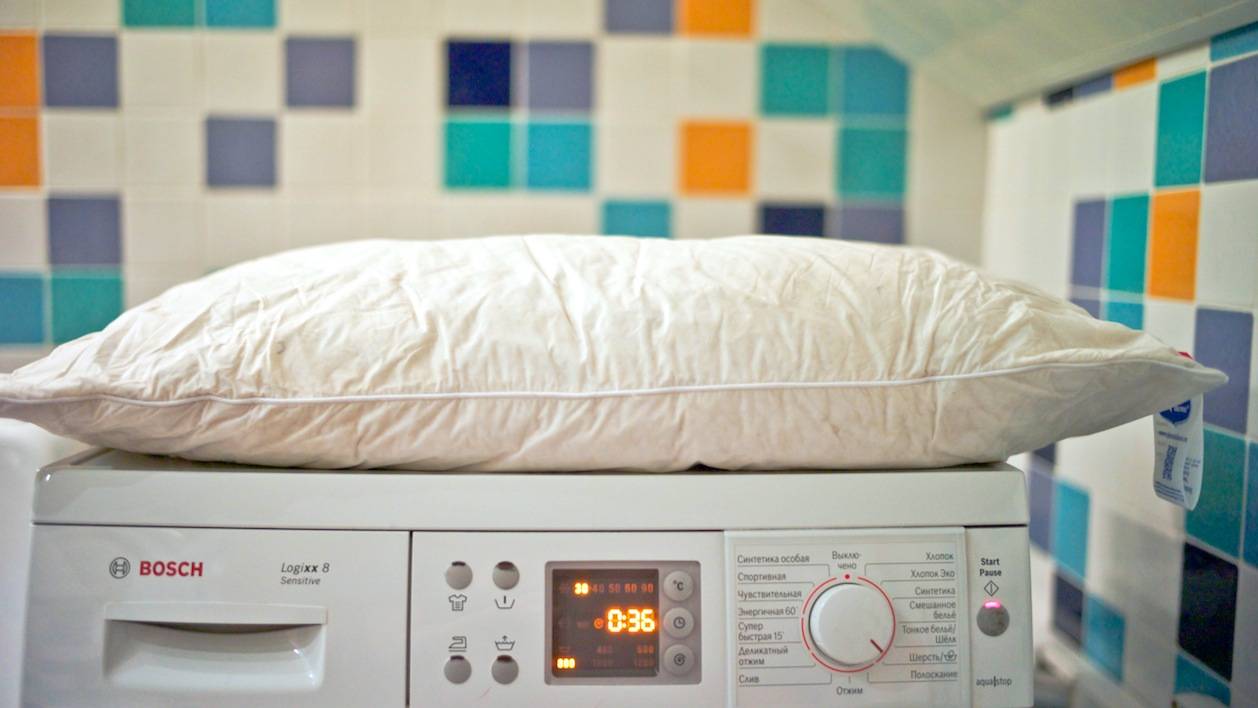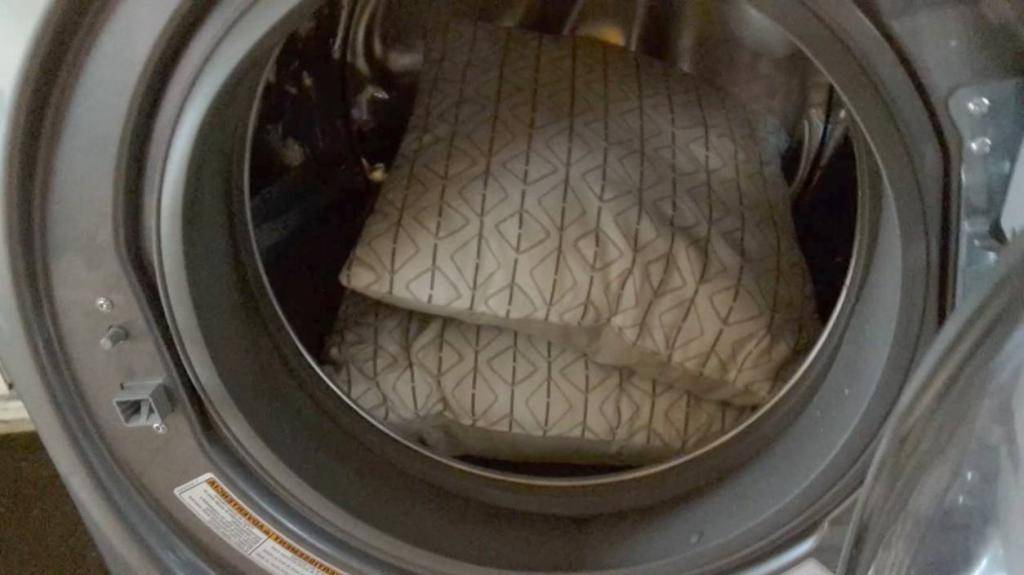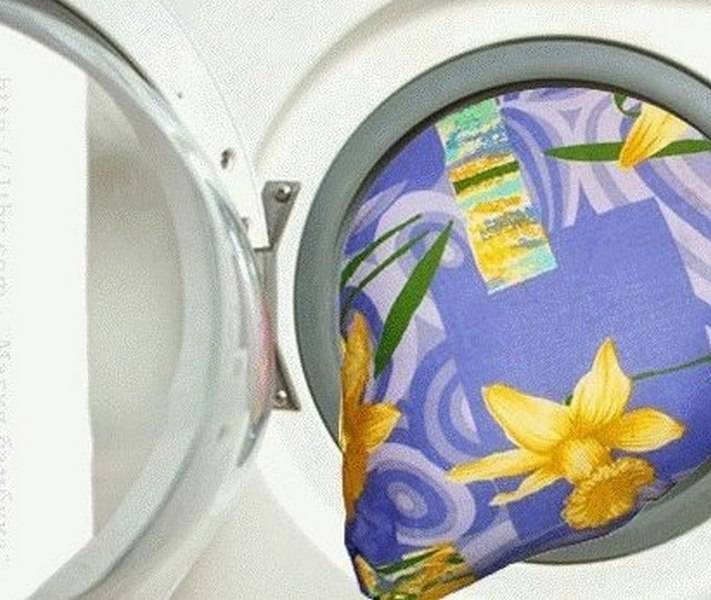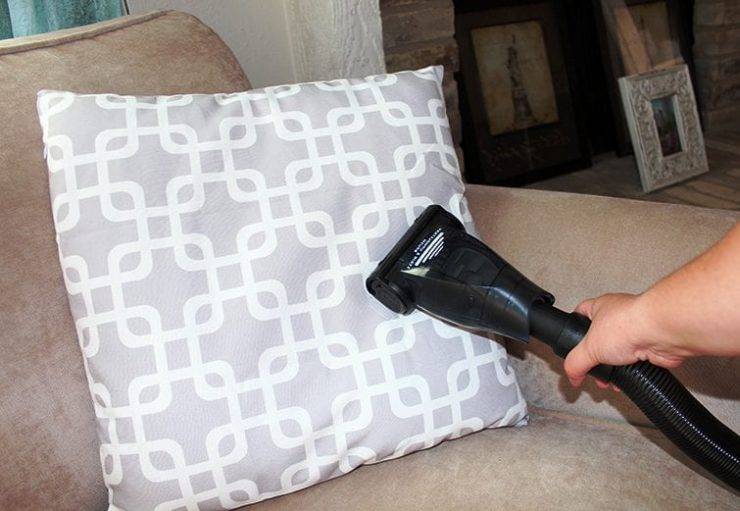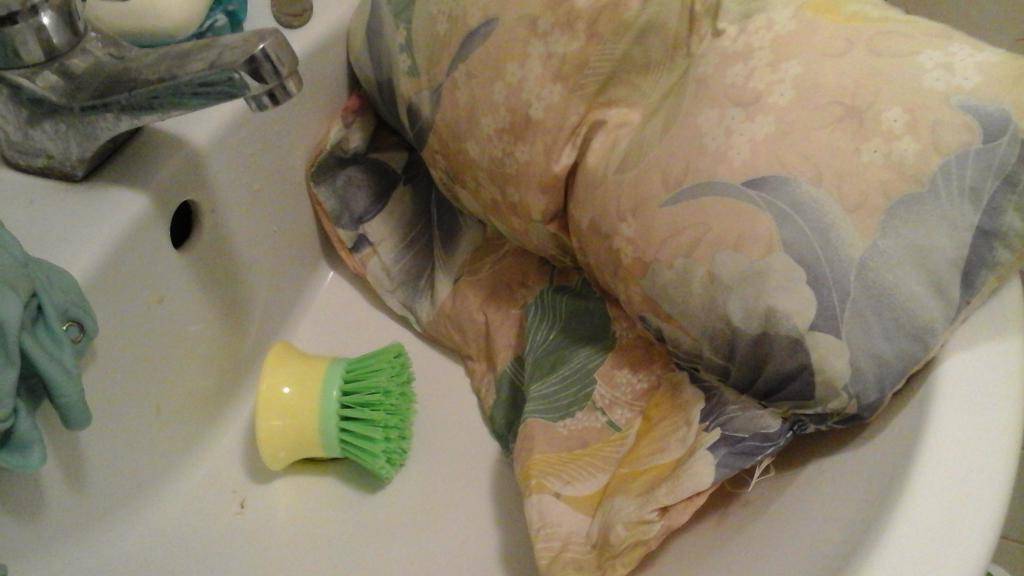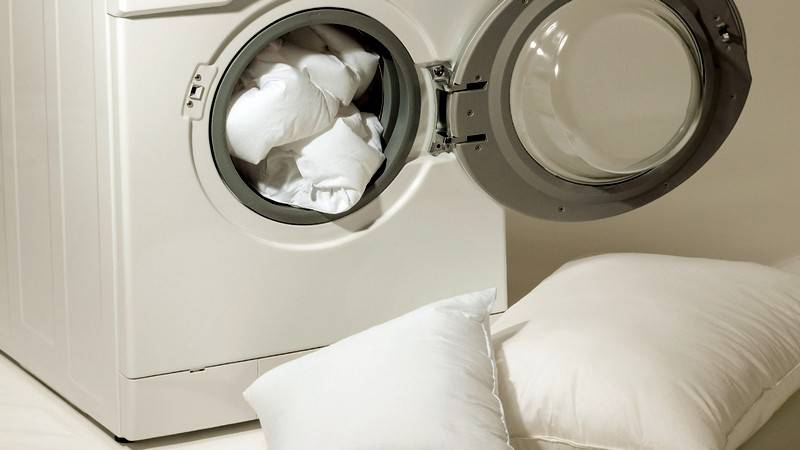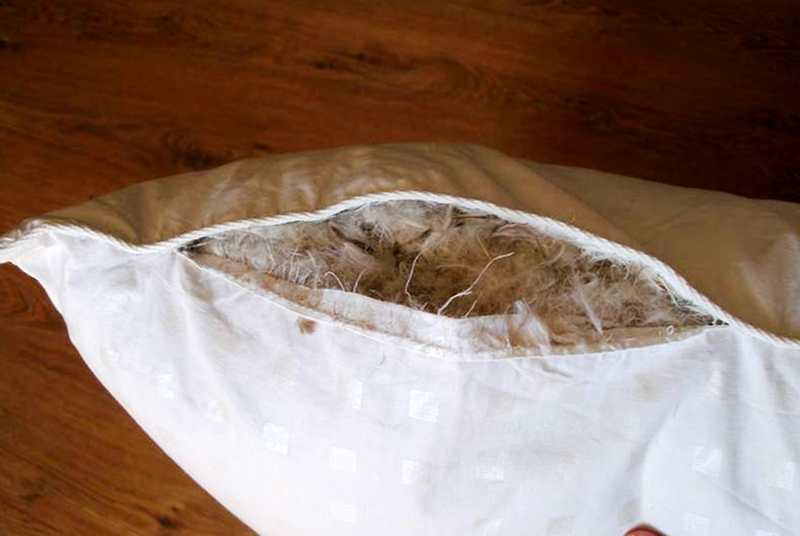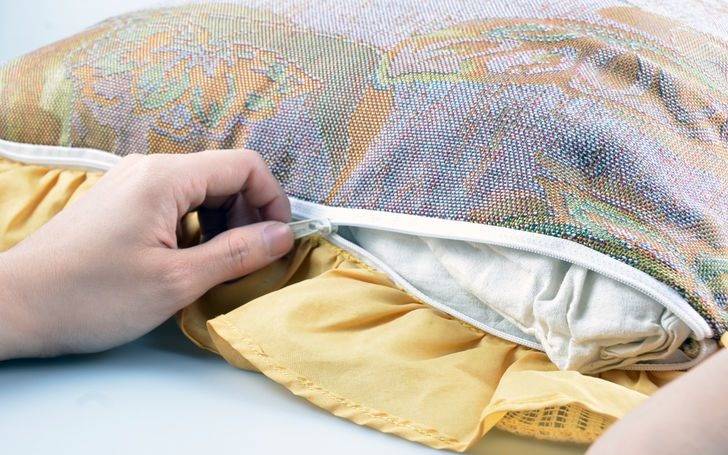3How to wash a pillow in the machine machine
With the help of household appliances, the washing process is greatly facilitated. Pillows can also be cleaned from dirt in the washing machine, but only each type according to certain rules.
How to wash down and feather pillows
- The natural filler should be completely removed from the pillow case and carefully transferred to a washing bag. If you do not want to change the volume of the pillow, then purchase a separate bag for each product.
- Several bags can be washed in the washing machine. You can put naperny to them, but it is better to sew new ones. Choose a wash mode for delicate fabrics or hand wash. A feather with down does not like high temperatures, so set it at around 30-40 degrees.
- Be sure to include an extra rinse. This will help the detergents rinse out better from the filler. Spinning at high speeds can damage the pen. Choose a double spin, but with the lowest power.

How to wash bamboo pillows
- The bamboo fiber filler can be sent to the drum as a whole. Only in this case, check the integrity of the pillow case so that the threads do not come out of the pillow case.
- Cleaning must also be carried out with a gentle mode. Set to Hand Wash, low temperature, low spin speed. To wash out the detergents as much as possible, rinse twice. Therefore, after a complete wash cycle, set a separate rinse.

How to wash anti-stress pillows
- The filler in these pillows is made in the form of small but durable polystyrene balls. You can also wash the entire product, but just put it in a laundry bag. This will prevent the balls from getting into the water.
- Recommendations for choosing a washing mode: lowest temperature, gentle cleaning and additional rinsing. But it is not recommended to wring out the anti-stress pillow.
- This filler can be washed like feathers. Carefully cut the fabric and transfer the balls to the bag. After drying, fill a new pillowcase with it.

How to wash a pad from padding polyester and polyester
- Check the properties of the product before cleaning the synthetic filler. To do this, click on the pillow in the middle. If she takes the starting position, then go to wash. Deepening indicates the need to replace the product.
- Polyester and synthetic winterizer are machine washable well. But the temperature should not be higher than 40 degrees, the washing mode is gentle. Don't forget to rinse extra. Remove the spin.
- Hang the pillow on a string after cleaning to remove excess moisture. This will allow the water to drain naturally. If, nevertheless, the filler has strayed into lumps, then after complete drying, shake the product well.

Prepare pillow filler
In fact, it is easy to clean properly at home. If the down pad is small and will fit into the drum, you can machine wash it entirely by pulling on an extra pillowcase. In the case when the product is too bulky, you will have to cut the material, take out the filler and "scroll" it in two or three passes.
So, first you need to cut the napert and place the down-feather in a dry basin. Next, you need to take fabric bags, ordinary pillowcases will do. Put filler in them and sew your homemade bedcloths well. Be sure to check the tightness of the seam, it must be strong so that the bag does not break and the fluff does not fill the drum of the washing machine, otherwise it will lead to sad consequences.
Next, each of the "new" pillows is washed, it is better to throw 2-3 bags into the machine at once.It is recommended to put special balls or tennis balls into the drum, which will "beat" the filler in the process. No need to tamp down the fluff - the looser it is before cleaning, the better.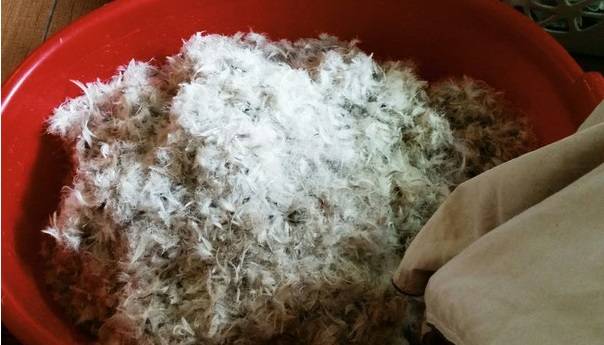
How to properly wash your pillow
Preparatory phase
Regardless of the type of filler, the pillow must be cleaned of dust before washing. This is done by knocking out. If you ignore this stage, then during the washing process all the dust will remain on the pillow, but in the form of stains, which is difficult, and sometimes impossible, to get rid of.
For feather pillows, special preparation is required, which consists in purchasing special covers for washing. If they are not available, you can use old pillowcases, which must be firmly fixed. These covers are loaded with the contents of the pillow, divided into several parts. After washing, it is dried, mixed and poured back.
 The pillow must be prepared for washing - beat it, clean it from dust, ventilate it.
The pillow must be prepared for washing - beat it, clean it from dust, ventilate it.
Handwash
Hand washing the pillows is fine. Moreover, it is even more preferable for feather products, as it prevents fluff from churning. The rules for hand washing are as follows:
- Water should be at room temperature (no more than 30 ° C).
- A powder or a gel-like agent thoroughly dissolved in water is used as a detergent.
- It is better to use a bath as a container, in which the filler is soaked for three to four hours.
- After the end of washing, the material is carefully wrung out using a sieve and distributed into small bags.
- The bags are placed in the open air until completely dry.
 Before washing your pillow by hand, be sure to read the rules for such washing.
Before washing your pillow by hand, be sure to read the rules for such washing.
Machine wash
You can wash the pillows in an automatic machine either as a whole or with the removal of the filler. The second option is more preferable, as it allows for better washing and drying. Separate washing also makes it possible to apply various modes to the cover, including the use of bleaches. In this case, the product is neatly unpicked along the seam, and the material is placed in small portions in special covers.
 Tip: when washing the pillow in the washing machine, select the “delicate” mode or “hand”.
Tip: when washing the pillow in the washing machine, select the “delicate” mode or “hand”.
When washing with a machine, a gentle or delicate mode is selected - 30-40 ° C and reduced speed (no more than 400-600). This will prevent the filler from warping and rolling.
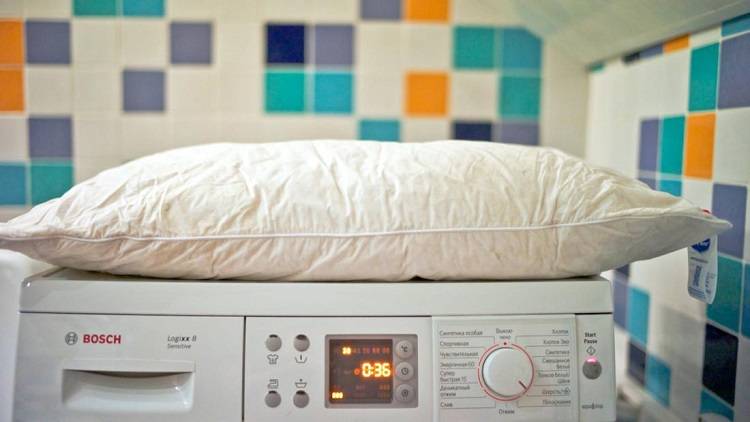 The water temperature should not exceed 30-40 degrees.
The water temperature should not exceed 30-40 degrees.
As a detergent, it is worth choosing not washing powders, but various liquid products, since they are easier to wash out. Additional rinsing will be useful. Bleach should be used only for covers, as they act in a detrimental way on fillers.
 Choose liquid detergents for washing powder.
Choose liquid detergents for washing powder.
For proper balancing, it is best to wash a couple of pillows at the same time, or spread the filler over several covers. It is also recommended to place some tennis balls in the drum to prevent the material from rolling.
Pillows are dried in a horizontal position, for example, laid out on clotheslines or in a dryer. The room should be warm and well ventilated, ideally with a supply of fresh air. The pillow must be periodically whipped, shaken and turned over, which will help to avoid caking of the filler and knocking it into a single lump.
 The area where pillows are dried should be well ventilated. Drying outside is the best option.
The area where pillows are dried should be well ventilated. Drying outside is the best option.
Steam cleaning
This cleaning is preferable for feather pillows, especially those made from chicken feathers, as moisture affects it negatively. Steam cleaning requires a steam generator, a handheld steamer, or a steaming iron. These devices will help to clean the cover, get rid of linen mites and bacteria, and eliminate unpleasant odors.
The cleaning process is as follows:
- Heat the water to the lowest possible temperature.
- Place the pillow in an upright position. It can be placed on a chair, suspended from a rope, or secured to the rungs of the bed.
- Steam the product two to three times on both sides.
- Dry the pillow in a warm and well-ventilated area. Every half hour or hour, it must be straightened and the filler must be pushed.
- Put on a pillowcase after completely dry.
 This cleaning option works well for feather pillows.
This cleaning option works well for feather pillows.
The nuances of washing products on a down and feather basis
Preparatory stage

Manufacturers of sleeping accessories with natural "filling" recommend washing the contents in parts - this is especially true if it is not small in size or a machine with a small load. You can take pillowcases or sew a similar material as covers for the filling material.
You need to unpick it on one side along the seam carefully and slowly, pour the contents into a large, dry container (basin, bucket, etc.). Arrange the "filling" in prepared pillowcases or sewn bags and sew them up properly. Also, do not fill the covers tightly, otherwise the feather will not stretch well. It is better to take this issue responsibly - if a bag of fluff or a feather opens during washing, it can damage the drum or the motor of the machine. The naperniki are washed separately or, if possible, replaced with new ones.
How to wash?

The modern detergent market offers a large selection of powders, gels, capsules and other liquid detergents for washing different types of fabrics. You can also purchase a special detergent for household fillers. Gel and liquid detergents are sold for natural fillers.
If you choose to wash your organic litter with regular powder, be prepared that it won't rinse out, and it will be unhealthy to sleep on such a pillow. Such washing is fraught with allergies, dermatoses and other unpleasant symptoms that the powder can cause. If it is not possible to purchase a care product for organic fillers, then you can buy a washing product for wool or delicate laundry.
How to wash pillows

We load two covers (four into a machine with a large load) into the drum and set the mode: now everyone, even over-aged machines, have a delicate mode; modern models have a special mode for blankets, pillows and other printed textiles - "down" or "hand wash". If possible, set the minimum temperature - 30, 40 degrees and the spin mode at a minimum speed (up to 400). Pour liquid detergent into the powder compartment and start the machine.
Rinsing
In any mode, an additional rinse should be used to thoroughly rinse out the detergent composition and residual dirt. The minimum rotation speed during spinning is set in order not to damage the delicate and fragile structure of down and feathers. At more than 800 revolutions, such an organic filling will turn into "porridge".
Drying
Proper drying of the down and feather cushions guarantees a good cleaning result
Here are some subtleties of this important process:
- Immediately after removing the covers with a feather from the washing machine, you need to knead them with your hands, shake them properly, to prevent the formation of lumps and clumping of the material.
- And to remove excess moisture and speed up drying, you need to put the covers on a cloth folded several times, a sheet or a large terry towel. Then wrap it all in an elastic roll and leave for 10-15 minutes - the fabric will take some moisture.
- Down pillows are best air dried. Arrange a general cleaning of bedding in the warm season, then they will dry out in one and a half to two days of warm dry weather.If there is a need to wash these household items in the cold season, then the room where drying is planned should have good natural or artificial ventilation. It is not recommended to use heat drying, in order to avoid deterioration of the quality of the printed material.
- Do not place covers near radiators, fireplaces, open sources of fire, in an area exposed to direct sunlight. Exposure to high temperatures is detrimental to organic fillers.
- You should not place them near sources of strong odors - down and feathers have the ability to absorb any odors, which will then negatively affect the quality of sleep.
- While the pillows are drying, they must be periodically turned over, whipped - this is especially true for down and feather products. Such material, during the drying process, has the ability to stick together and turn into lumps - if this is allowed, the pillow will have to be thrown away, it will become unusable.
- After the end of drying, transfer the filling material to a washed or new pillowcase, then sew up with a strong seam.
After that, the pillows will be completely ready for use, they will delight their owners with freshness and softness for more than one month.
General recommendations for processing pillows in an automatic machine

- You can wash them as a whole, with or without a cover. If it is preferable to wash it separately, then the seam on it should be ripped open and the filler is slowly pulled out. Then we put it in bags for washing. By the way, they are often replaced with ordinary pillowcases made of dense material.
- Only after completing all the procedures, you can start assembling the pillow.
- Separately, the washing method is laborious, but it allows you to better wash and dry the pillow filling and apply a variety of washing modes, bleaching, soaking, etc. to the pillow case.
- The modes are selected based on the recommended processing temperature of the product - this is, as a rule, 30-40 degrees in delicate and modes, and on the number of spinning revolutions (no more than 600).
- It is better not to use the drying mode for pillows - hot air jets will ruin the product with one hundred percent probability.
- For washing such a delicate household item, it is better to choose a liquid detergent - it rinses out better from the fibers than powder.
- You should not use bleaches, even the most gentle ones, according to the manufacturer. They will negatively affect the condition of any type of filler.
- If the products for sleeping are of medium size, then it is better to place two cars in the drum at once (if we are talking about miniature ones, then 3 and 4 are possible). Then they will stretch well and the wash result will be better. If there are tennis balls at home, feel free to send them to the car along with pillows (a couple of pieces will be enough); they will not allow the filler of the product to crumple during washing.
- Dry the pillow in a warm, well-ventilated place (on the balcony, in warm weather with slightly open windows or outside). It must be dried in a horizontal position, periodically turning it over so that the filling composition does not get lost in one lump and does not cake.
Which pillows tolerate washing well

Most types of these accessories for sleeping and relaxing are well tested with a typewriter - with the right choice of detergents and mode. Products with natural fillers are well tolerated in a typewriter: feather and down, sheep and camel wool, bamboo. Synthetic fillers (synthetic winterizer, holofiber, silicone balls) also tolerate this process well.
You should not send to the car pillows stuffed with cotton wool, with a "memory" function, with various natural fillers, orthopedic hard pillows that can damage the drum. Such household items, in order to avoid damage and deformation, are cleaned manually or replaced over time.
The whole process can be divided into five stages:
- Preparation.
- Choosing a detergent.
- Loading, washing.
- Rinsing products.
- Drying.
5Which pillows shouldn't be washed at all
- Among the variety of fillers, there are examples that absolutely cannot be washed, even by hand. Such popular buckwheat husks are not washed, but only dried in the open air. Then she shifts into a new bed-case.
- Pillows that are designed to support the head and neck during rest, as well as products "with memory" should only be wiped with cold water. Use a soft cloth for this and then wipe the surface dry.
- Sleep products made from natural or artificial latex cannot even be wetted. They are cleaned with a damp cloth and then dried thoroughly.

In order not to spoil the shape of the pillow, you should choose the correct cleaning for it, depending on the type of filler. But at the same time, the product needs to be thoroughly dried.
For more information on washing pillows from different fillers, see the video:
Features of washing padding polyester pillows
It is necessary to wash padding polyester pillows with medium frequency. If you do this too often, then they will quickly lose not only their elegant appearance, but also their practical properties - it will become uncomfortable to sleep on them. At the same time, the lack of washing leads to the fact that mites start up inside and dust accumulates. It is required to wash the padding made of synthetic winterizer at least once a year, but not more often than three times a year.
To wash bedding without compromising its structure, you need to adhere to several rules:
- The synthetic winterizer is washed only in cool water - high temperatures have a very negative effect on the durability of the material.
- It is necessary to squeeze the synthetic winterizer with machine and hand wash very carefully, if it is washed in an automatic machine, then you cannot set high speed for spinning.
- It is not recommended to use ordinary detergent powder to wash the accessory, its microscopic particles will remain inside the filler, which will be harmful to health. Only gentle liquid products should be used.
- Along with the detergent for padding from padding polyester, bleach should not be used. Aggressive chemicals remaining inside the padding polyester will worsen the quality of night sleep and affect your well-being. In addition, an obsessive chemical smell may well remain on the product.
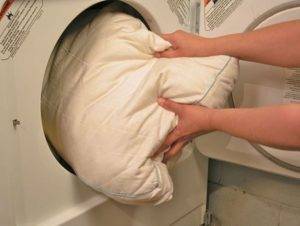
Important! Before washing a thing, you do not need to soak it, just pour it over with cool water and immediately start the main wash. In principle, it is not recommended to keep the synthetic winterizer in water for a long time - this has a bad effect on its structure.
Features of drying the product
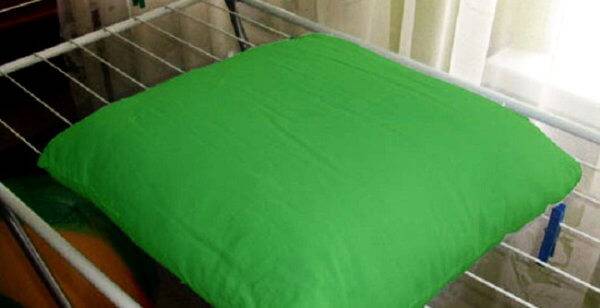 Like any pillow, the anti-stress product is dried horizontally.
Like any pillow, the anti-stress product is dried horizontally.
Drying your accessory properly is just as important as washing it. It is enough to make light pressure movements to drain the water. Allow excess liquid to drain, and only then take the pillow out to the balcony or into a warm room. Dry the product horizontally, and do not forget to shake the item periodically. This will help to distribute the filler evenly inside the garment.
A sleep accessory will serve you for a long time if you follow all the recommendations. Use the correct wash settings and anti-stress care products.
Can soft toys be washed
To care for soft toys, several cleaning methods are used:
- handwash;
- machine wash;
- dry cleaning;
- wet cleaning;
- freezing.
Laundry is most often used, considering this method to be the simplest, less troublesome and effective. You can wash children's toys, but you should make sure of the following:
- there are no glued parts that can come off during washing;
- the weight is insignificant, this must be taken into account, since very large and heavy samples absorb a lot of water;
- no blocks for batteries and other electromechanical parts;
- the thing is made of synthetic materials, products made of natural fibers are quite rare, when washed they shrink and deform;
- stuffing with the use of artificial fibers is applied; you cannot wash animals stuffed with sawdust, down, cotton wool, feathers.
Thus, machine wash can be used to clean medium-sized plush toys made of synthetic materials without glued parts and electromechanical blocks.
On the label of each product, the manufacturer indicates the composition of the materials used for the manufacture and recommendations for care. Felt bunnies and bears can only be washed by hand.
But large toys, which are problematic to place in the drum of the washing machine, should be dry-cleaned. They can be hand washed. But in this case, giant toys are difficult to squeeze and dry.
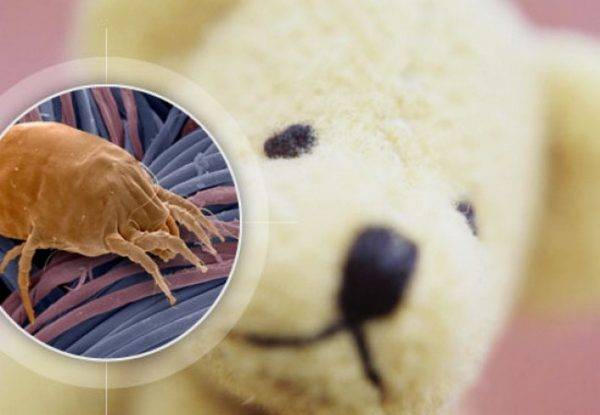 Dust mites live in upholstered furniture and interior
Dust mites live in upholstered furniture and interior
A long drying process does not give a guaranteed result. There is a great risk that the filler will rot, it will be quite difficult to get rid of the smell of dampness and mold.
Preparing for washing
We procure materials
Washing down pillows in the washing machine begins with the preparation of auxiliary materials.
- You need to buy in the store or sew on your own from 4 to 6 (depending on the size of the pillow) bed-cases measuring 40 × 40 cm. If you sew yourself, then choose a thin fabric, but with frequent weaving. The feather tick is just right.
- We purchase the same number (by the number of naperniki) studded rubber balls.
- We buy a special detergent for washing down (feathers).
- A respirator or gauze bandage (the latter can be made by yourself from a wide bandage).
- Depending on the drying method, you will need old pillowcases or a large piece of cellophane wrap.
- We buy or sew a new pillowcase.
- The final touch is lavender oil. It can be replaced with any other that you like best.
After preparing all the materials, we study the weather forecast: a hot sun should be shining in the next two days.
We prepare the product
Obviously, it is not possible to machine wash pillows entirely out of down feathers. Therefore, we proceed to the autopsy. Better to do it over the bathroom. Dry the tub and close the drain. Since small fuzz will settle on all surfaces, wear light-colored clothing: this will eliminate the need for subsequent cleaning. Cover your face with a gauze bandage.
Carefully rip open the naperl and transfer the contents to the small naperniki prepared in advance. The extraction of the fluff will take place with the least loss if manipulations are carried out under a gauze cover. The less content there is in one napkin, the better it will stretch and rinse out. We put one spiked ball in the received pads, they will not allow the feathers to stray into one lump. We sew up the resulting blanks.
Rules for hand washing down pillows and the main differences from the machine method
Hand wash has to be used if the product does not enter the drum of the washing machine, as well as in the absence of a suitable mode. Depending on the method chosen (with or without filler removal), you need to wash the product itself or the fluff.
Sequencing:
- Pouring the filler into the basin, napernik or putting on the cover.
- Soaking the product in warm water with a previously dissolved powder.
- A pillow made of artificial swan down can be rubbed slightly during washing, but with a natural filler, the movements should be whipping.
The most difficult thing with the manual method is a high-quality rinse. A large volume of water is required to remove the remaining detergent, as well as a high-quality but gentle spin.
The main difference between hand washing is the high energy consumption and laboriousness of the process, therefore, if it is impossible to use the washing machine, it is better to use the laundry service,dry cleaning and use a vertical steamer.
Updating the pillow in the washing machine
Not all housewives enjoy painstaking hand washing or soaking very dirty items. So you can simplify this task by using the washing of feather pillows in the washing machine. But it is worth noting that this type of washing can be performed only in the correctly selected mode, on which the final result depends.
Instructions:
- Fold the gauze fabric in 5 layers so that it turns out to be a bag. It is imperative to properly sew its edges, since even gentle washing in a typewriter has a harder effect on the product.
- Then open the pillow and spread the feather filling into several equal parts. Each of the parts must fit into the drum with a margin of space. Transfer feathers to bags and sew tightly.
- After that, place them in the washing machine, set the delicate wash mode. For machine washing, as well as for hand washing, it is necessary to use gels for woolen products. Pour the required amount into the special compartment and add the conditioner cap.
- The washing temperature should not be higher than 40 degrees, wash at minimum speed. Also, you should turn on the double rinse program.
- When these manipulations are done, turn on the machine and wait for the second rinse cycle. Before it, you will need to fill in 2 more air conditioner caps.
It is worth noting that if you decide to upgrade the feather pillows in the washing machine, you are putting the machine at risk, as the feathers can clog it. Therefore, it is necessary to carefully sew up the bags so that they do not have large holes.
And also you do not need to fill the machine "to the eyeballs", it is better to leave a little space - in order for the washing to be of high quality.

